This was my second time in Vietnam and my first time in Northern Vietnam. The first time was last year when due to work purposes again, I stayed in Ho Chi Minh City for around one month.
One of the symbols of a typical Vietnamese city and Haiphong, a colonial French-style opera house, topped off with giant national flags and a portrait of Uncle Ho to show who is in charge these days.
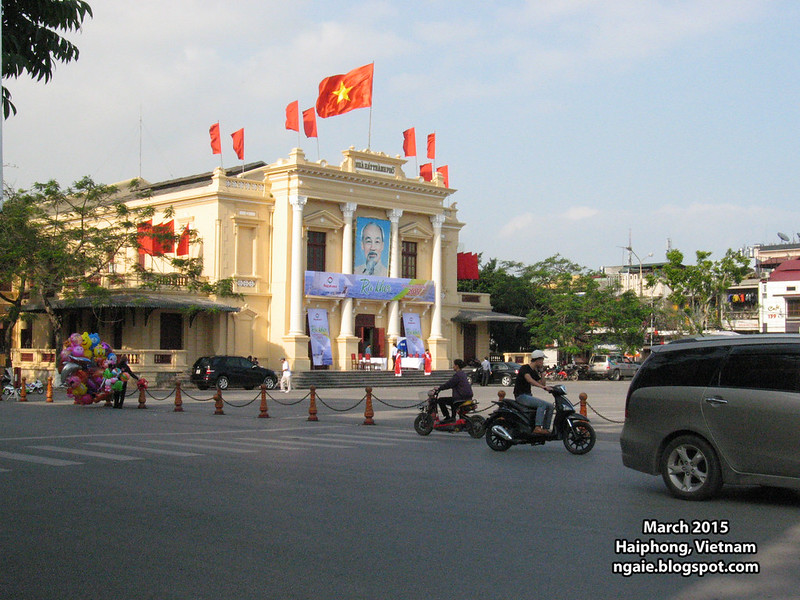
So where is Haiphong? It is a port city located around 2 hours east of Hanoi by car that is home to many factories in industrial parks that produce a lot of the "Made in Vietnam" goods that you see on store shelves nowadays.
Since Haiphong doesn't have an international airport, I had to fly from Tokyo to Hanoi and then once I landed at the airport in Hanoi, the assigned driver drove me directly to Haiphong.
I once again flew on Vietnam Airlines and compared to many North American airlines, the food and service was quite good. The only downsides was the lack of selection in the in-flight movies and the fact that the airline mileage accrual on Delta's SkyMiles was extremely stingy. (People don't call it SkyPesos for nothing)
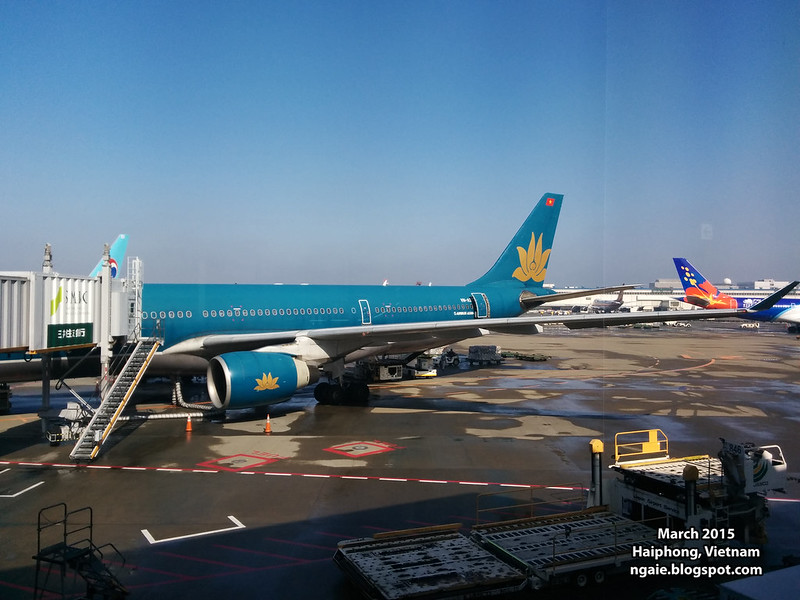
The in-flight meal of Vietnam Airlines. I would say it was better than meals I had recently with Cathay Pacific (a real disappointment) and United Airlines (the worst).

The hotel I stayed in at Haiphong was called the "Lac Long Hotel" and for less than US$50.00 per night it was quite a good deal.
It was extremely spacious, newly renovated and most importantly, it was really clean. To top it off, they even offered laundry service for free each day for 1 set of undergarments, 1 shirt and 1 pair of pants. It seemed that most of their customers were foreigners or Vietnamese people who were out in Haiphong to do business in those factories in the industrial parks and often needed to stay for long periods of time.
As an aside, while I was there, I meet a Taiwanese businessman who was an ex-civil engineer and was also staying at the hotel for a couple of months while he was getting ready to start up a factory to produce mechanical parts. The amazing thing was that he previously had stayed in Haiphong for 10 years, learnt the Vietnamese language and had previously retired only to "un-retire" because he was bored!
The room I stayed in at the hotel. The only thing that didn't work well was the speed of the Wi-Fi connection.
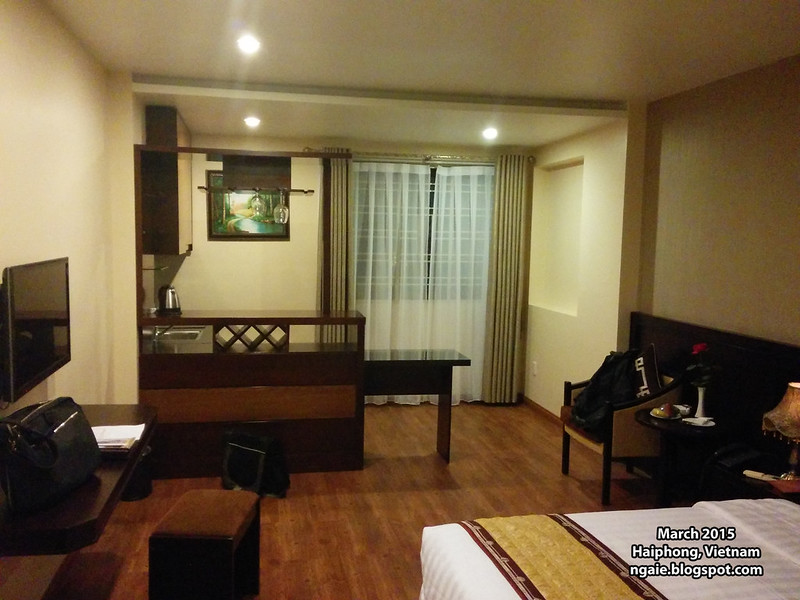
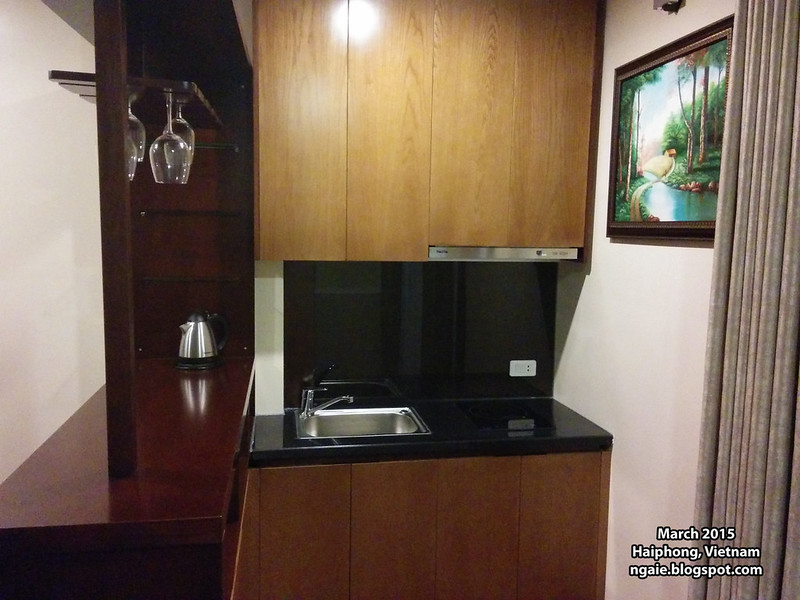
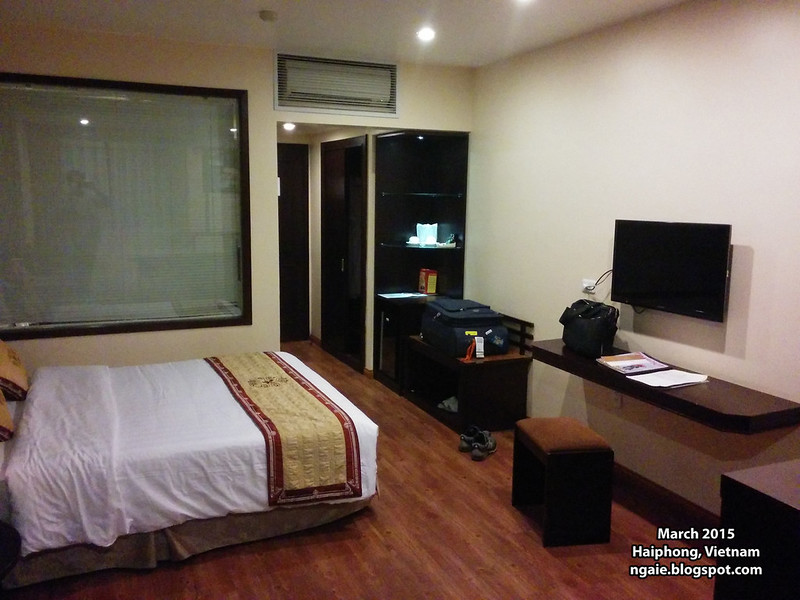
In the room, I noticed that the light fixtures had the "Panasonic" logo printed right on the fixture itself and as a former electrical design engineer/assistant lighting designer, I know that any self-respecting lighting designer would have a heart attack if they ever saw one of these things installed in their projects!

The purpose of the project I was working on was to study the feasibility of building 2 bridges to connect the city centre of Haiphong with industrial parks to the north of the city across the Cam River. I was assigned to be in charge of the traffic surveys so that the project team could see what was the existing traffic condition in the city so they could use the data to make future traffic forecasts. One of the things we had to do was to contract out the work of doing the actual traffic surveys to local Vietnamese consultants and one of the main tasks for being at the local city was to coordinate and to monitor their works.
Here, they set up cameras at a local hotel to record the amount of vehicles that passed by this cross section. The videos would be recorded for 24 hours and then afterwards the Vietnamese consultants would hire local university students to manually count the number of vehicles for all 24 hours (the labour cost is still cheap in Vietnam).
Usually in developed countries, they would install automatic vehicle counting devices at set locations so they could monitor the traffic situation year round.
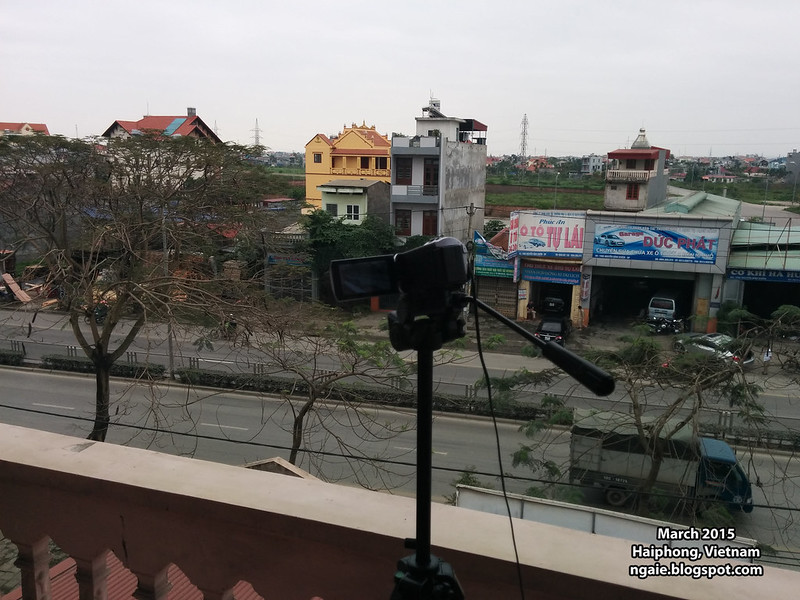
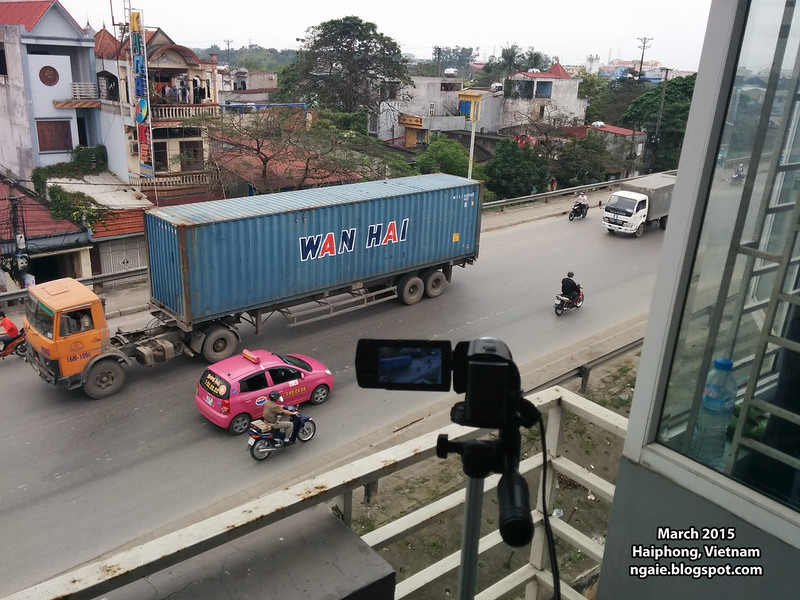
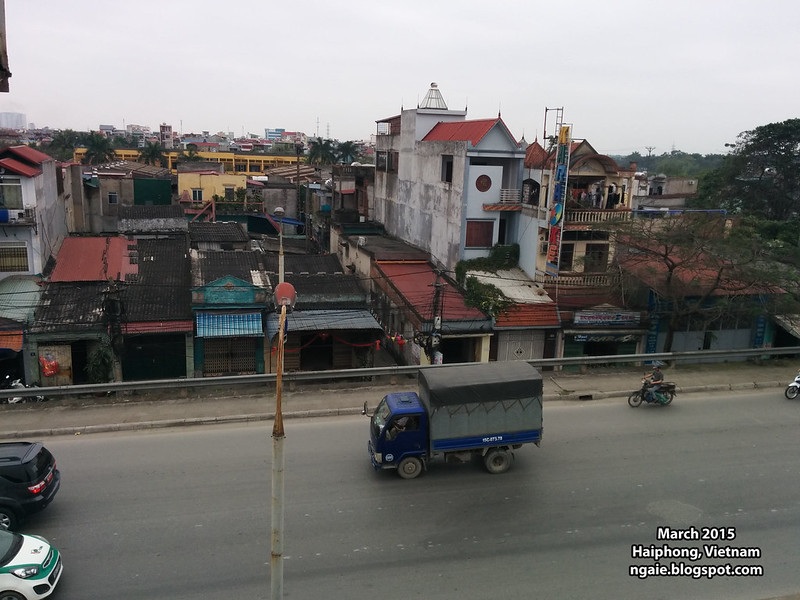
The Vietnamese countryside had a lot of hybrid Vietnamese-European like buildings.
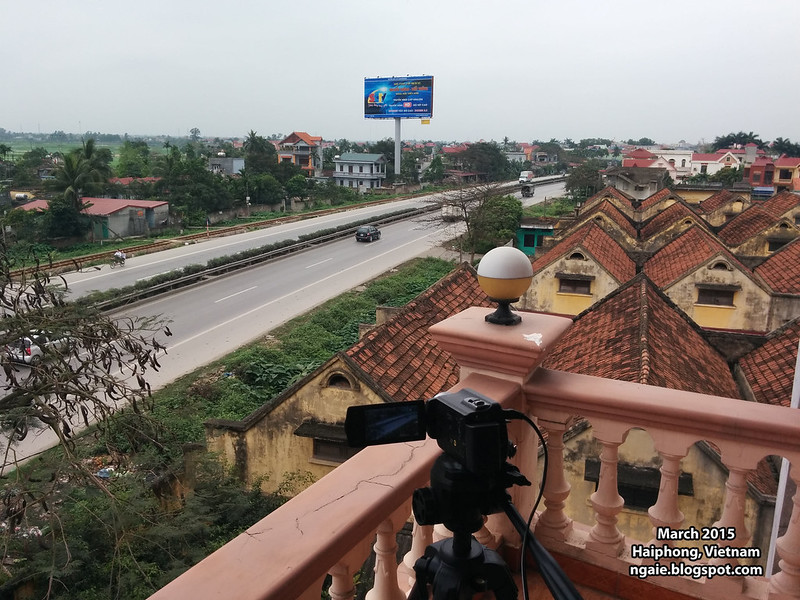
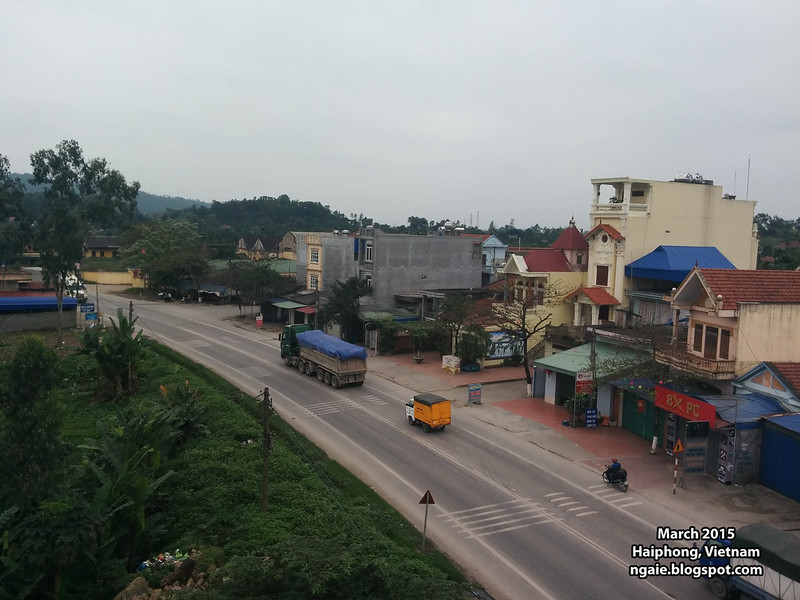
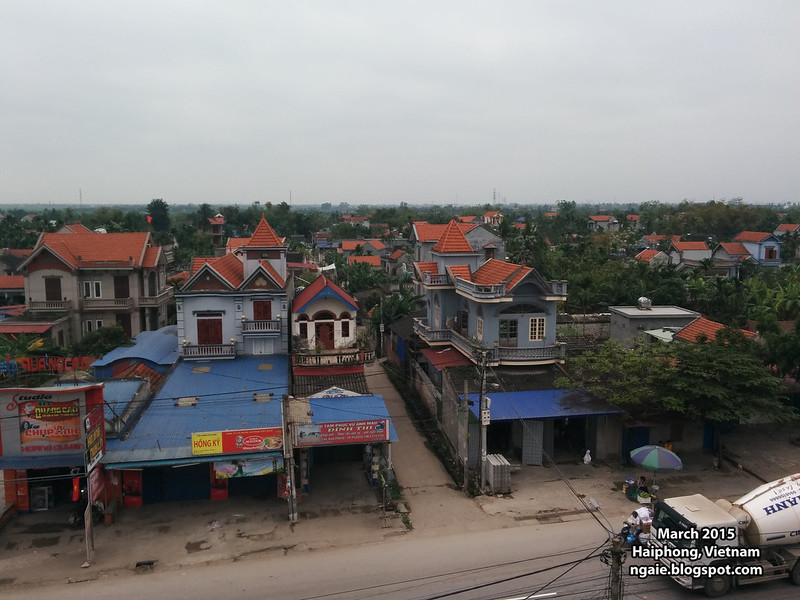
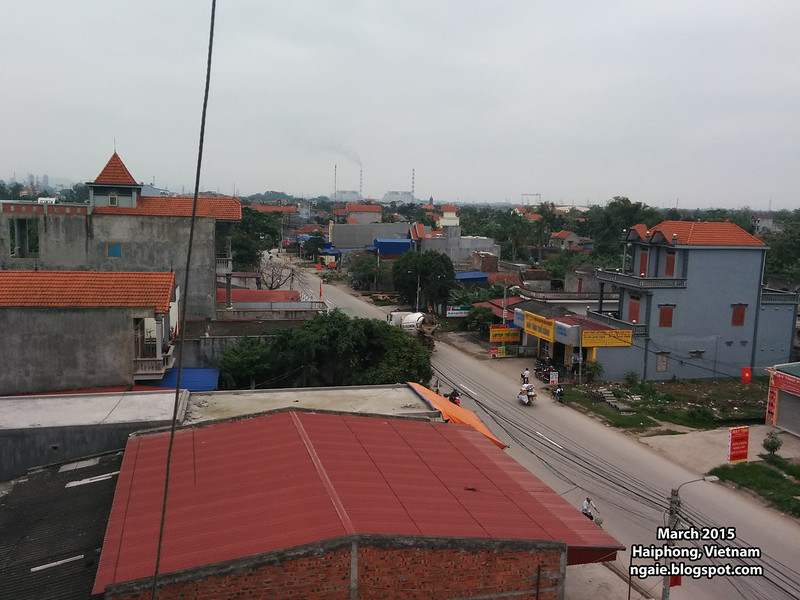
A typical street in the Vietnamese countryside. No one walks on the street because everyone has motorbikes.
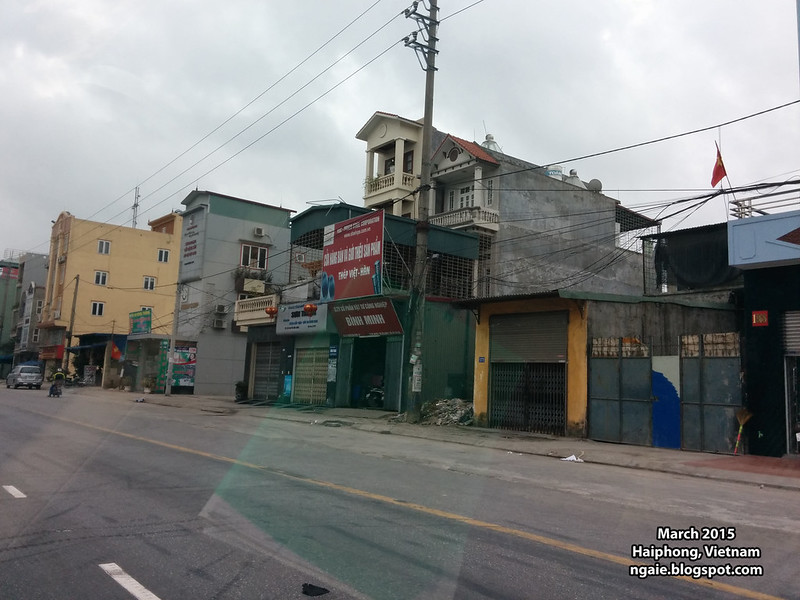
In addition to counting the number of vehicles, another task was to interview a sample of drivers to get a sense of where they came from and where they were heading in order to get a better sense of the traffic situation and also to use as inputs for the traffic forecast. With the cooperation of the traffic police, the Vietnamese consultants hired local students to fill out a questionnaire that we developed.
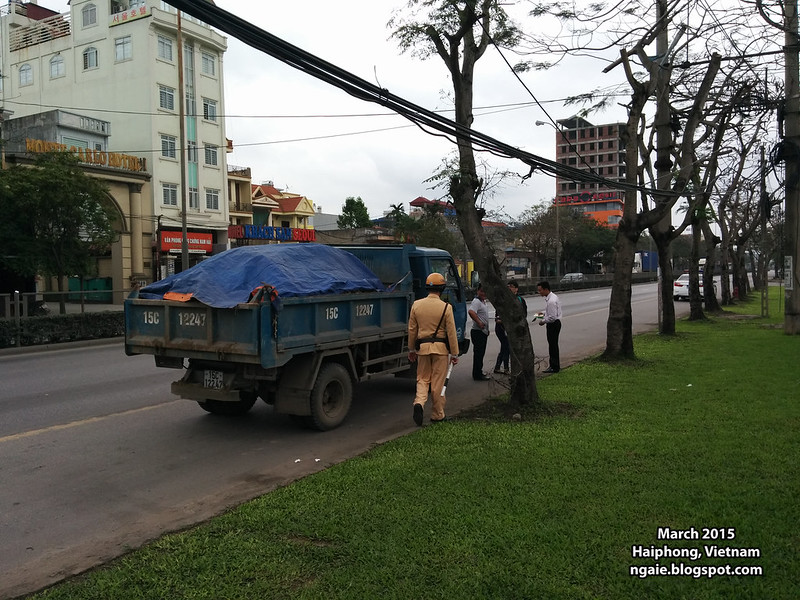
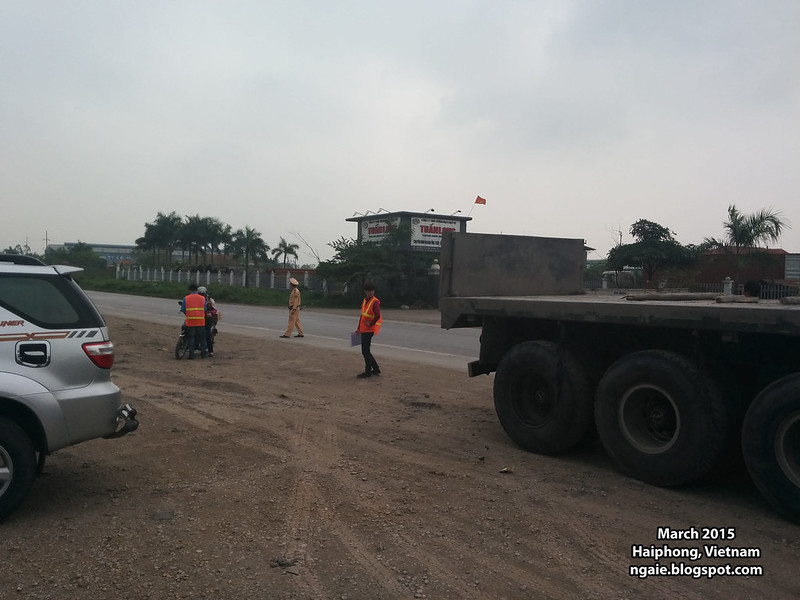

Driving down a typical street in Vietnam.
You have to have quick reflexes to dodge motorbikes, bicycles, pedestrians and anyone and anything that crosses the road. The driver who drove me to the various survey sites had absolutely no patience such that his driving style was if there was a car in front of us, he would start honking the horn like crazy, then use the opposite lane with *opposing traffic* to overtake the car in front of us! This happened on a regular basis.
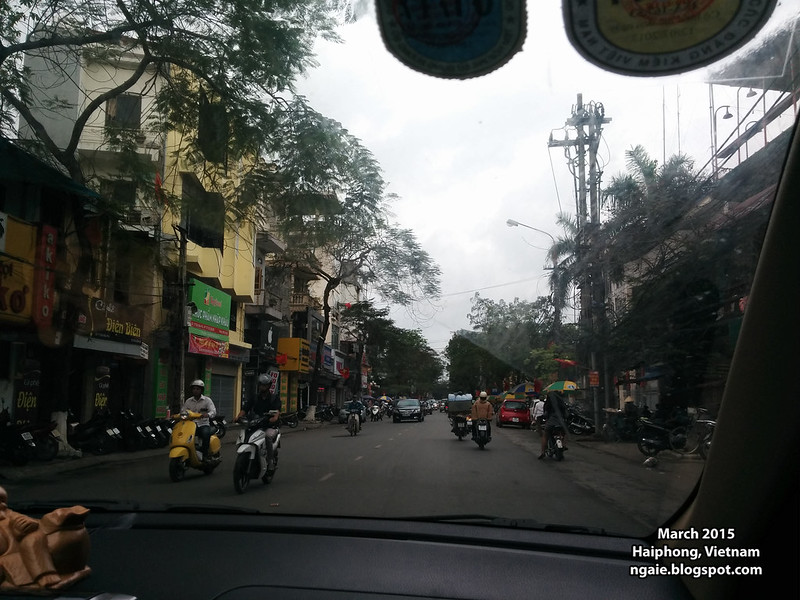
Crossing one of the bridges that was previously funded by Japan and now kind of deteriorating due to a lack of maintenance.

I wonder why the Japanese engineers designed a modern bridge without a barrier in the median to separate the opposing traffic, it seems unsafe to me...
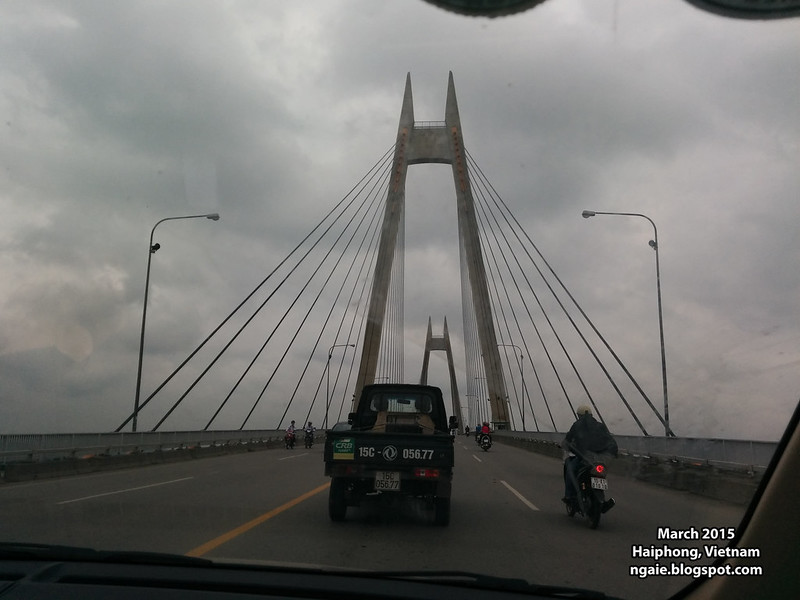
When I was there, an official project office had not yet been set up, so we had to work out of the local transport department's conference room "under the guidance of Uncle Ho and the Communist Party".
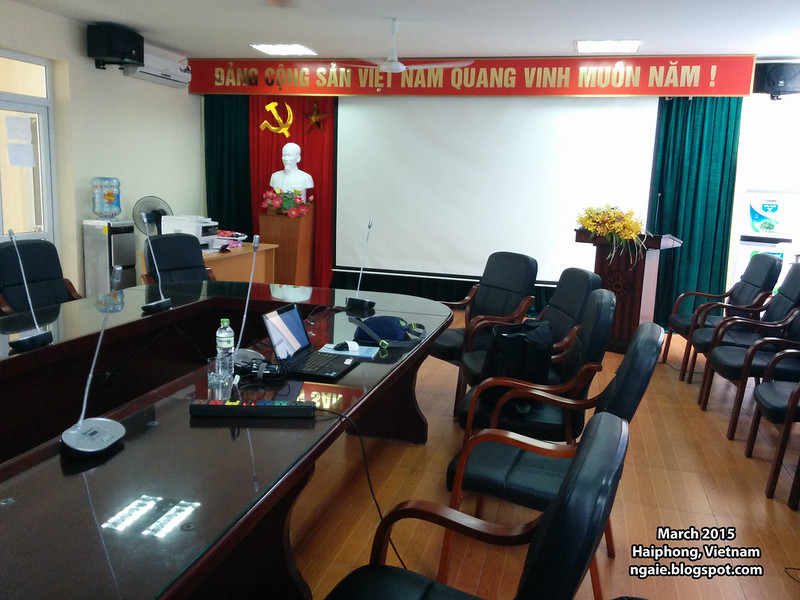
A typical street in the city centre of Haiphong.
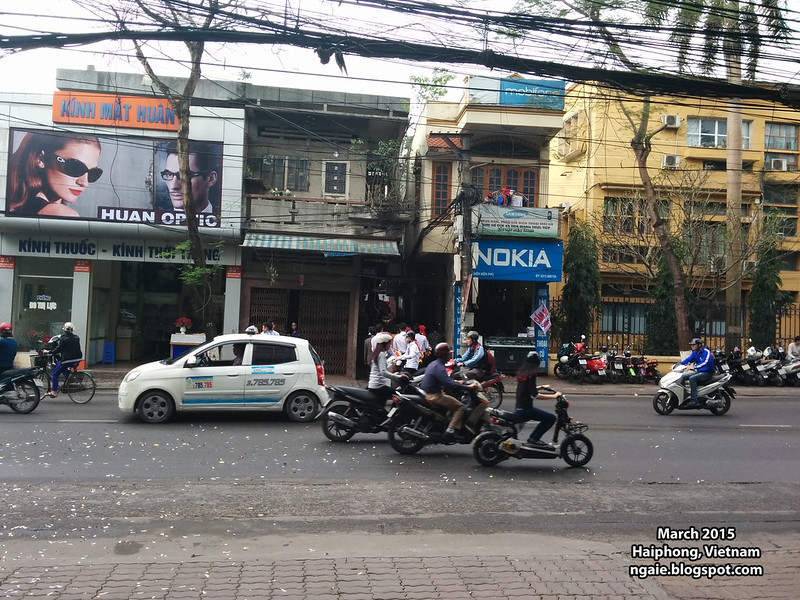
One of the bad things about Vietnamese cities is that because of the amount of motorbike users, walking around the city is extremely unpleasant.
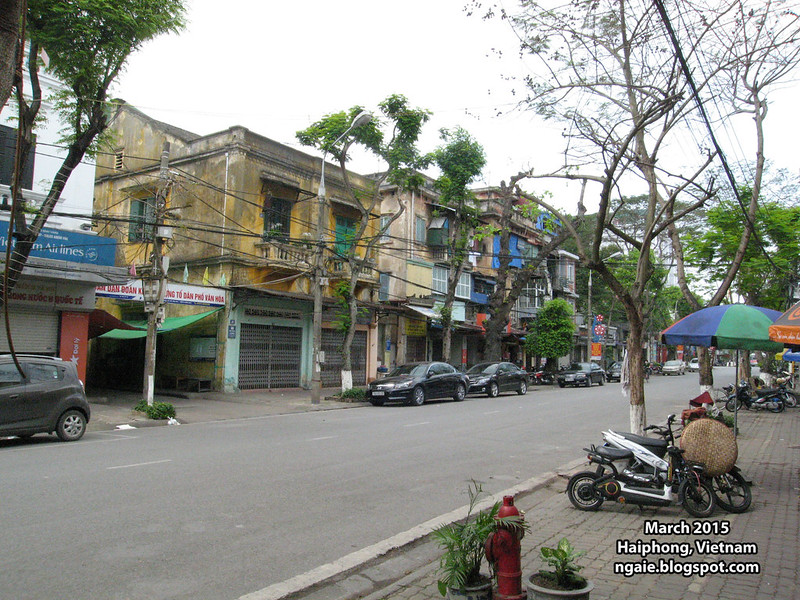
A lot of the sidewalks were de-facto motorbike parking spaces.
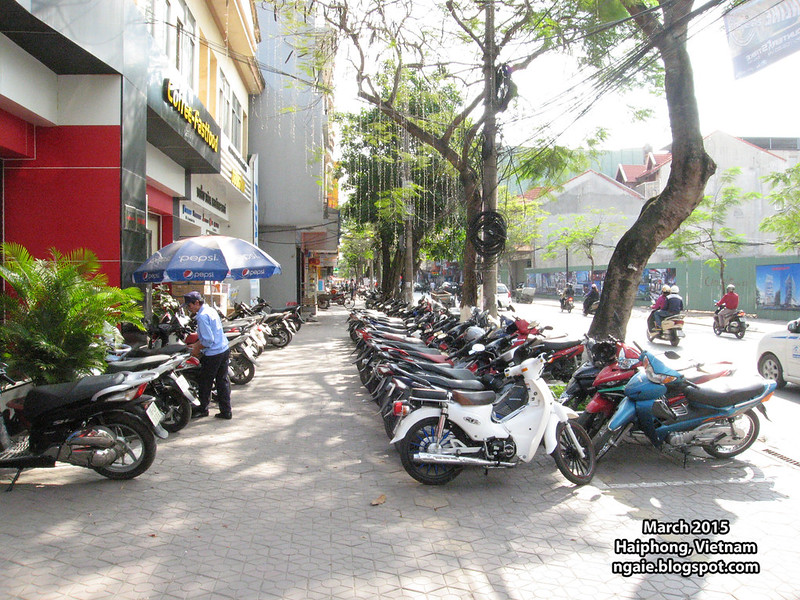
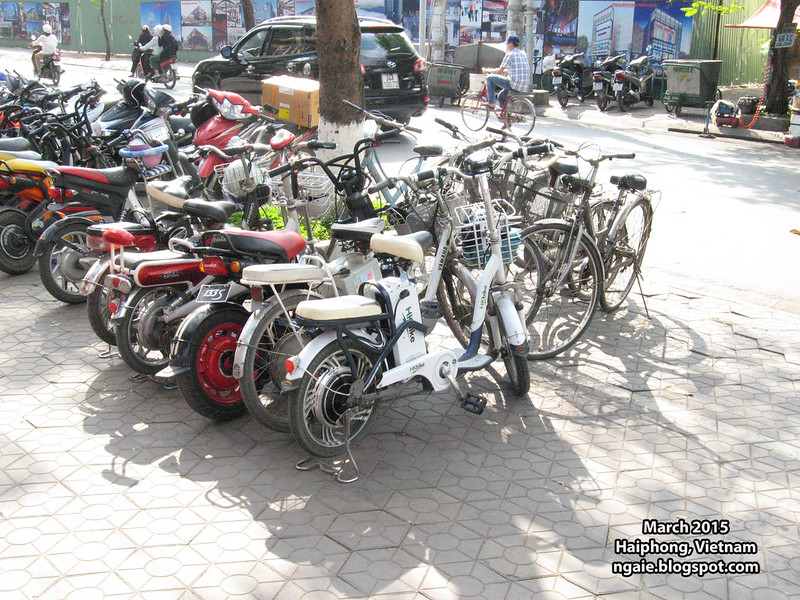
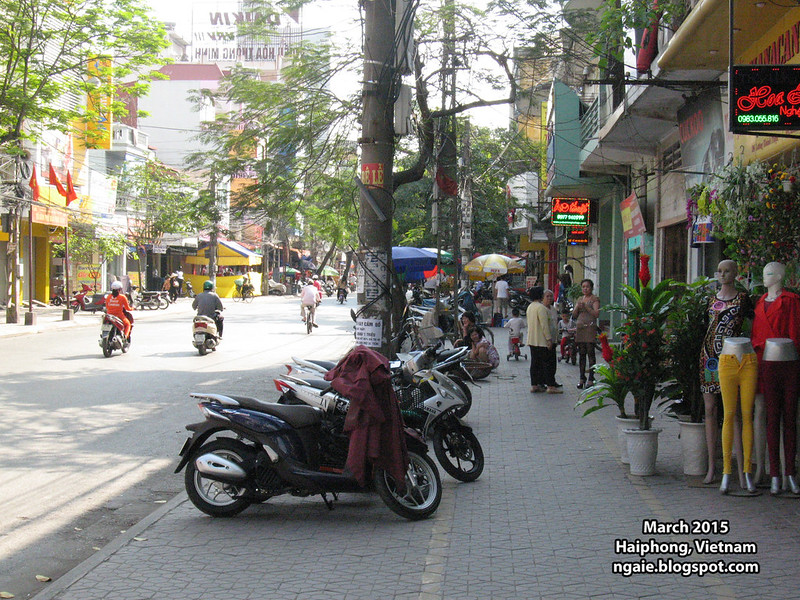
I also noticed a lot of these Chinese-made? electric bikes.
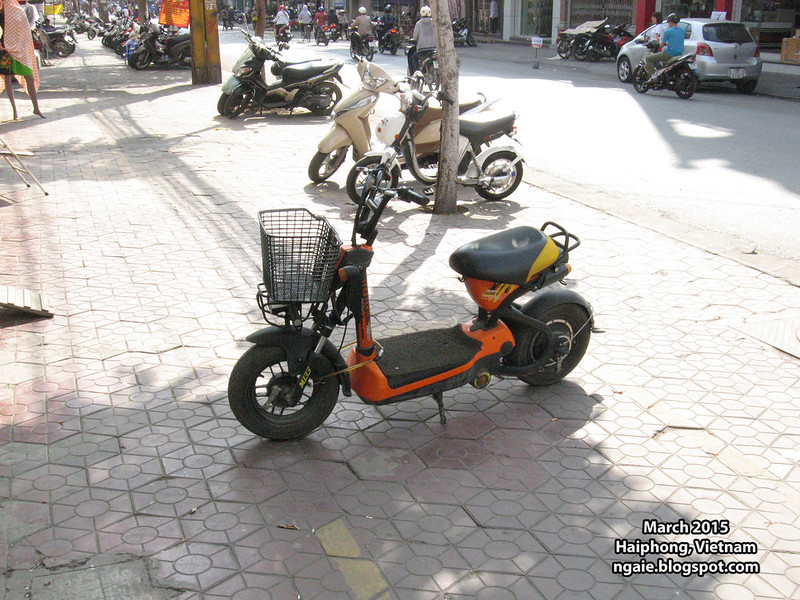
While I was there, almost everyday was cloudy and on one of the sunny days during the weekend, I walked around and explored the city by foot. Compared to the other megacities of Vietnam, Hanoi and Ho Chi Minh City, Haiphong is less chaotic and way more laid back. There seemed to be less motorbikes compared to the other 2 megacities and I still saw a lot of people riding their bicycles on the street.
Street barbers.
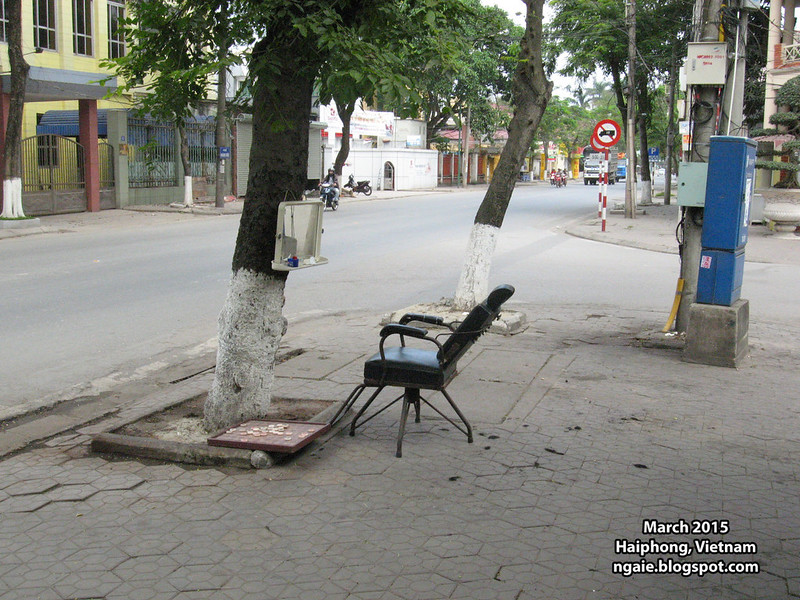
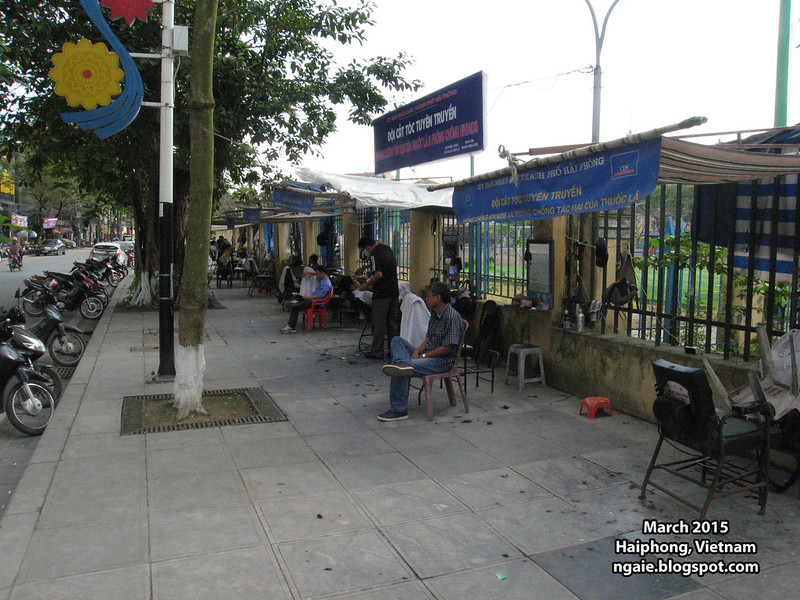
Local mini amusement park with rides.
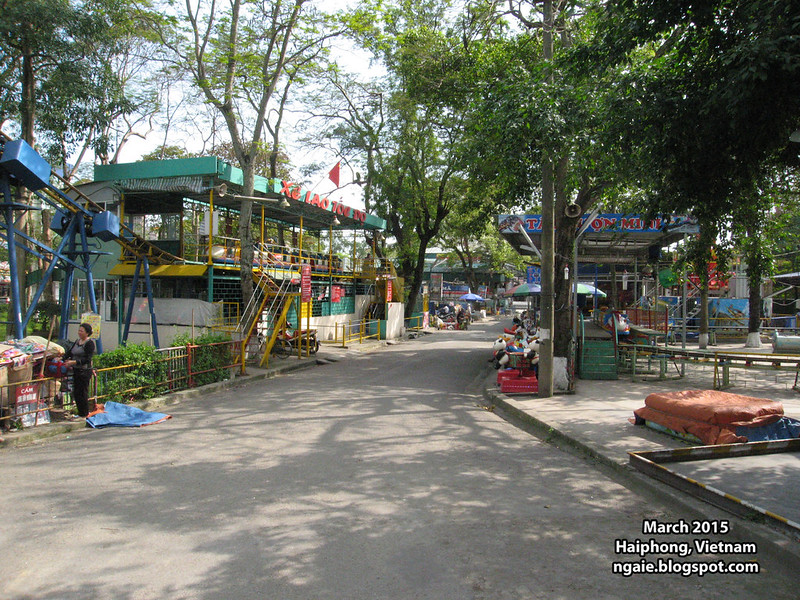
I wonder where they got that giant New Super Mario Bros. 2 image from for use as decoration?
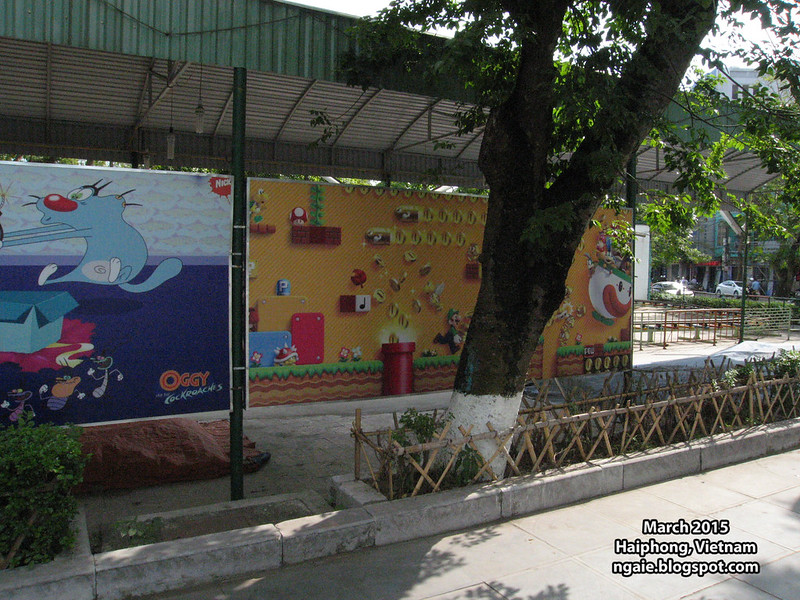
Balloon hawker. They would actually push their cart full of balloons along the road with the cars and motorbikes to try to make some sales.
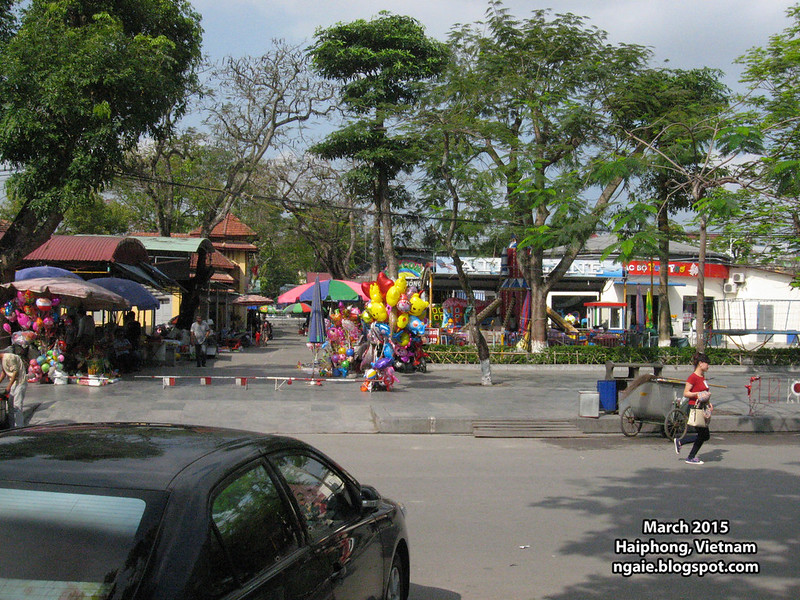
There were quite a few parks as well as a giant canal and promenade in the centre of the city.
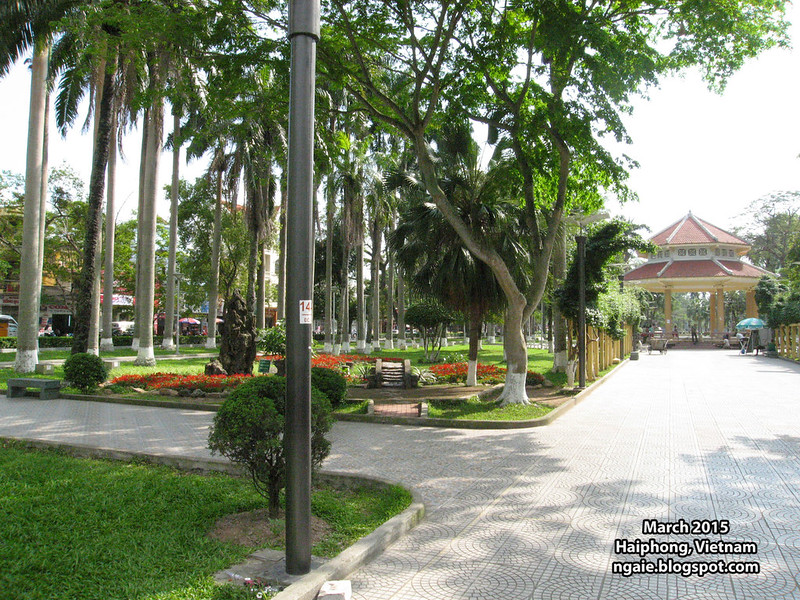
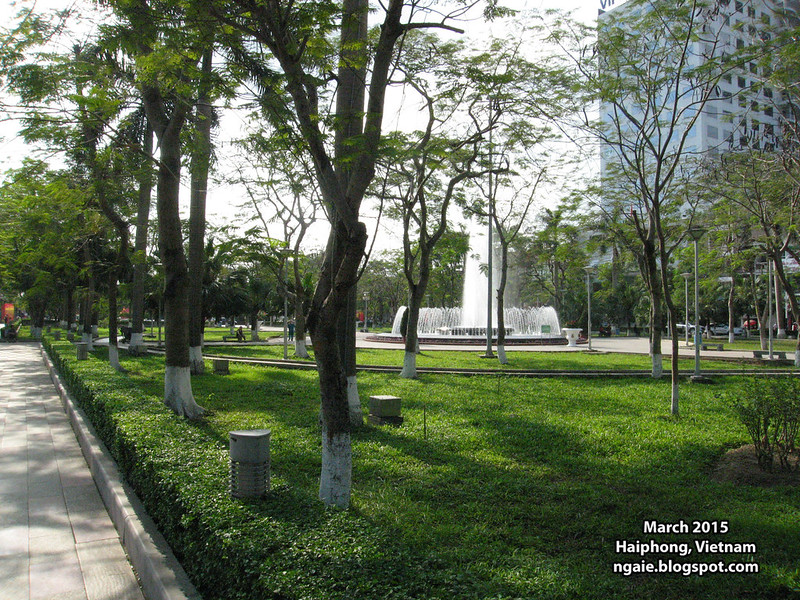
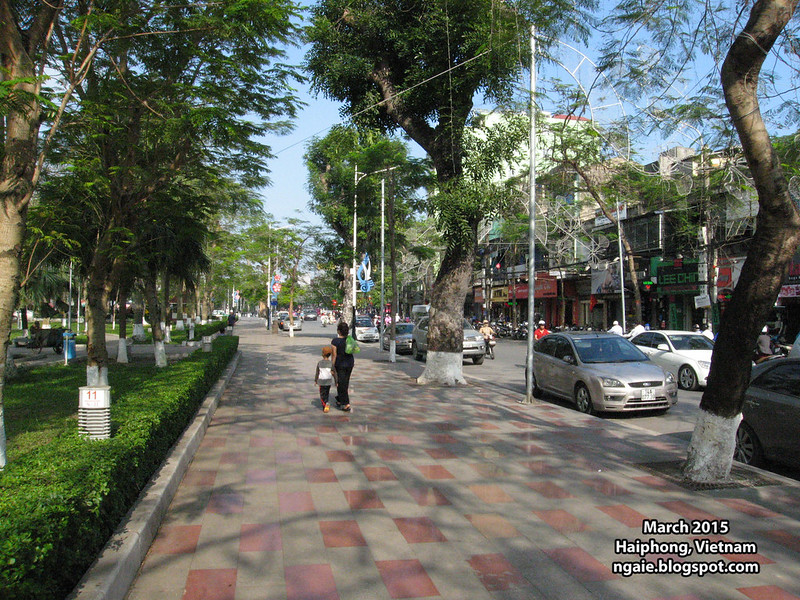
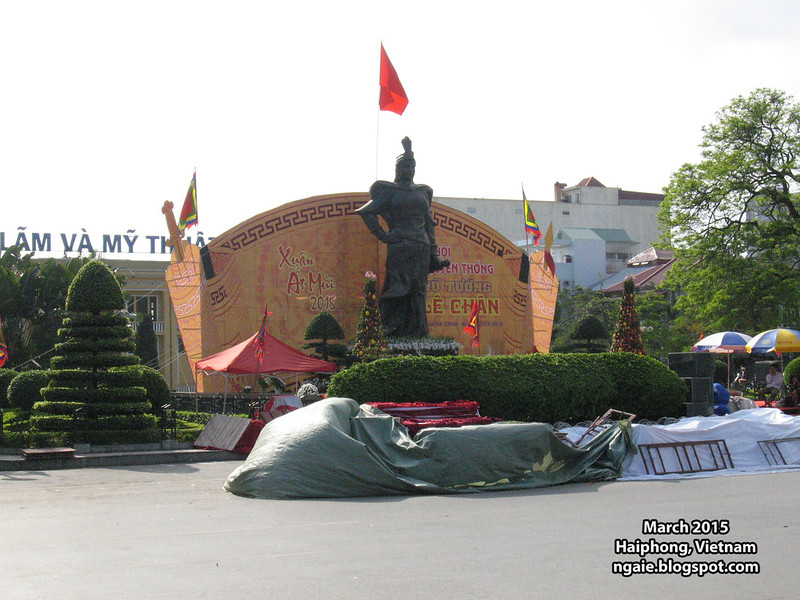
The symbolic centre of the city. The square with the giant national flag and the French colonial-style opera house with the Ho Chi Minh portrait. At night time, this was a popular place for the locals to play sports.
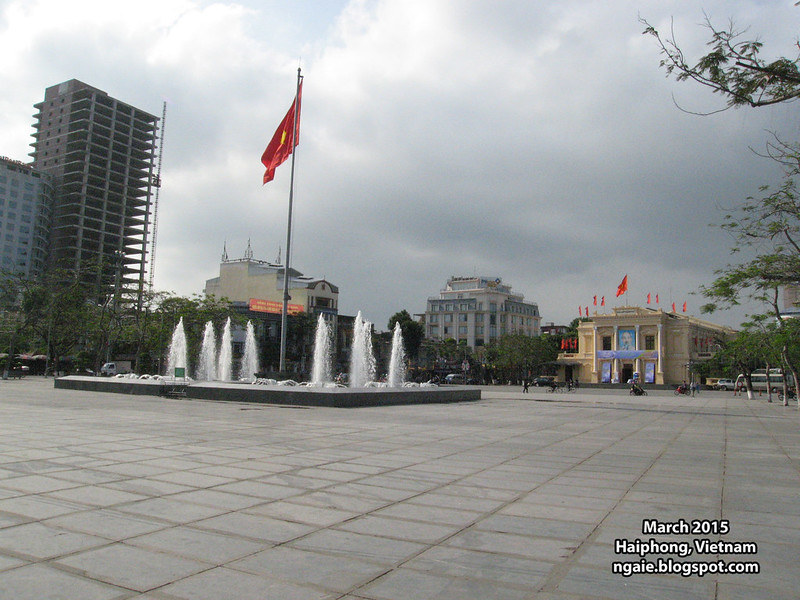
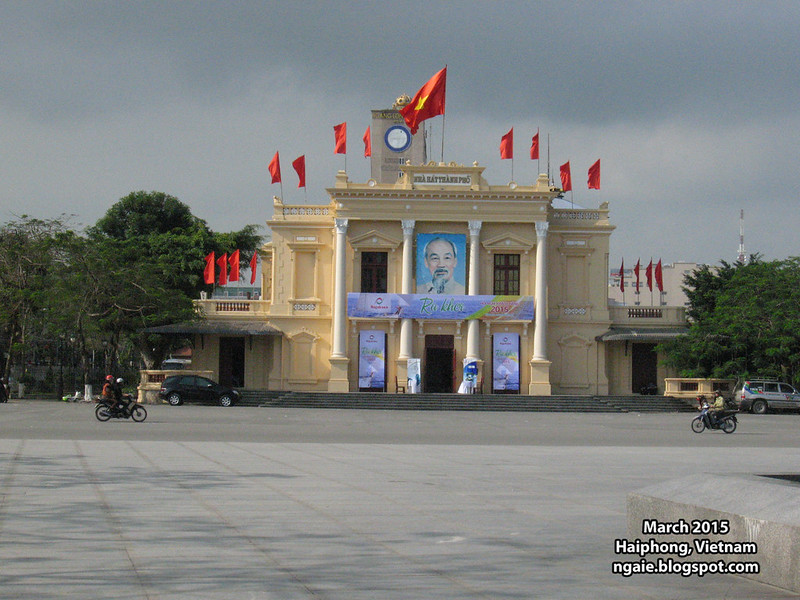
Balloon hawker in the background.

The canal.

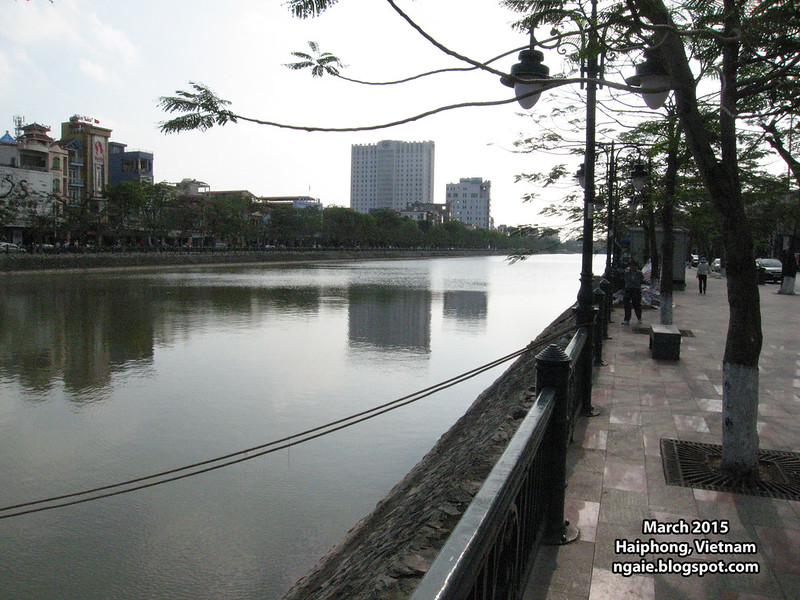
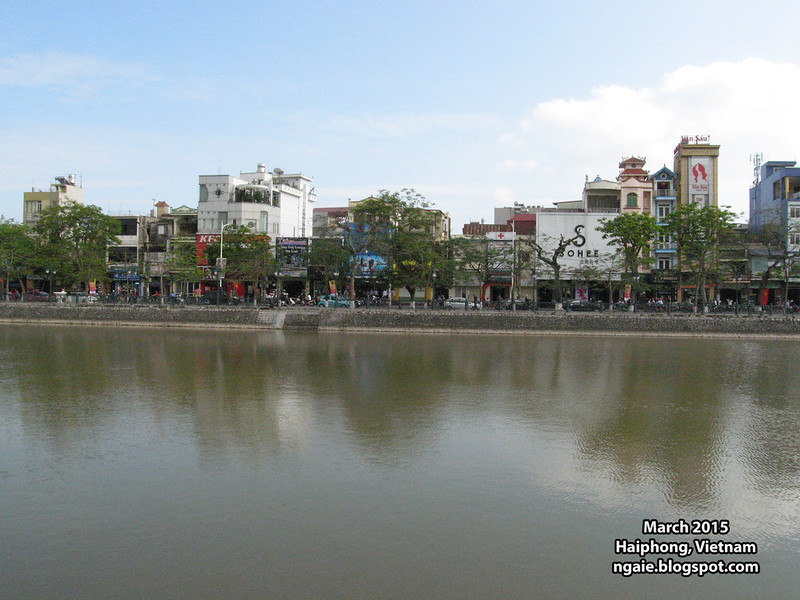
Various modern day propaganda.
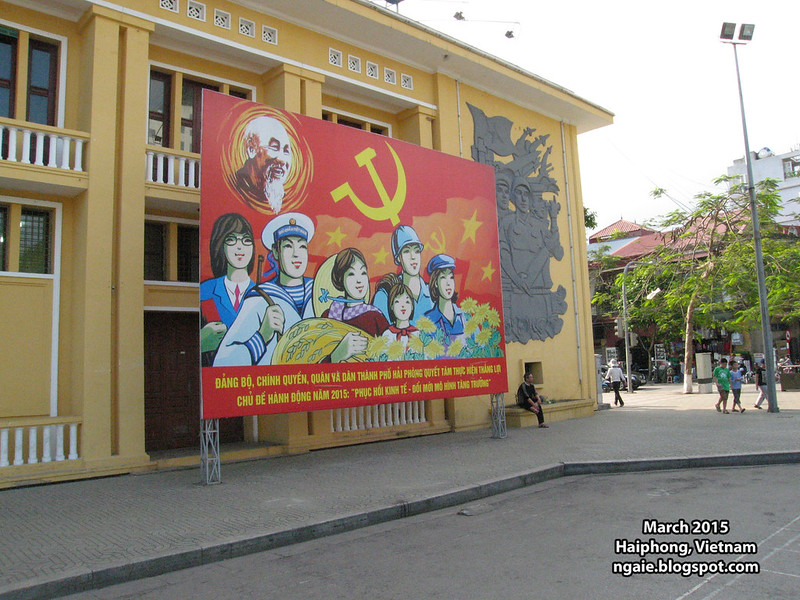
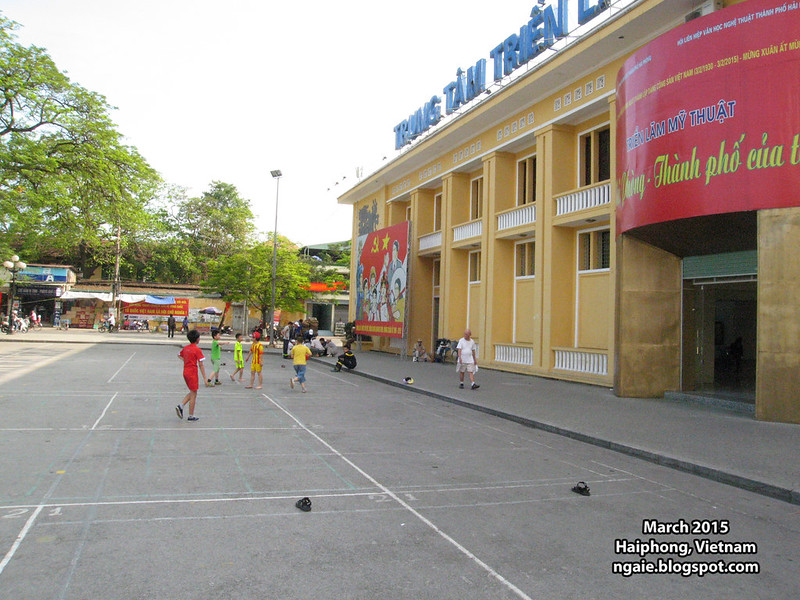
The Haiphong railway station area. You could catch one of the few slow moving trains to Hanoi here.
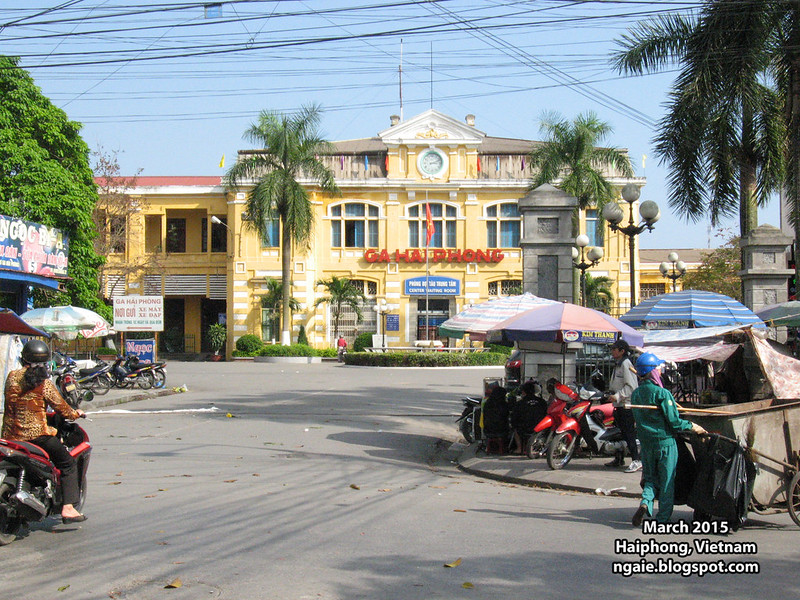
This is the type of intersection that you have to physically cross to get to the railway station.
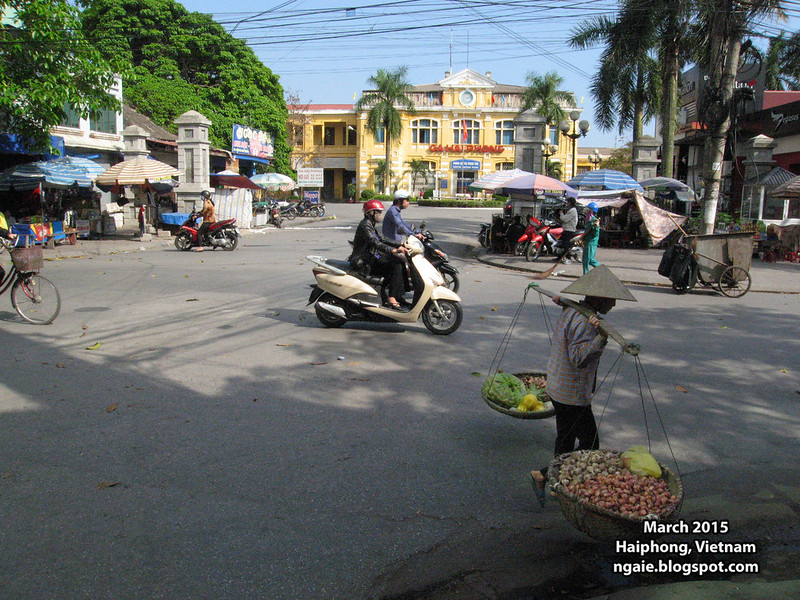
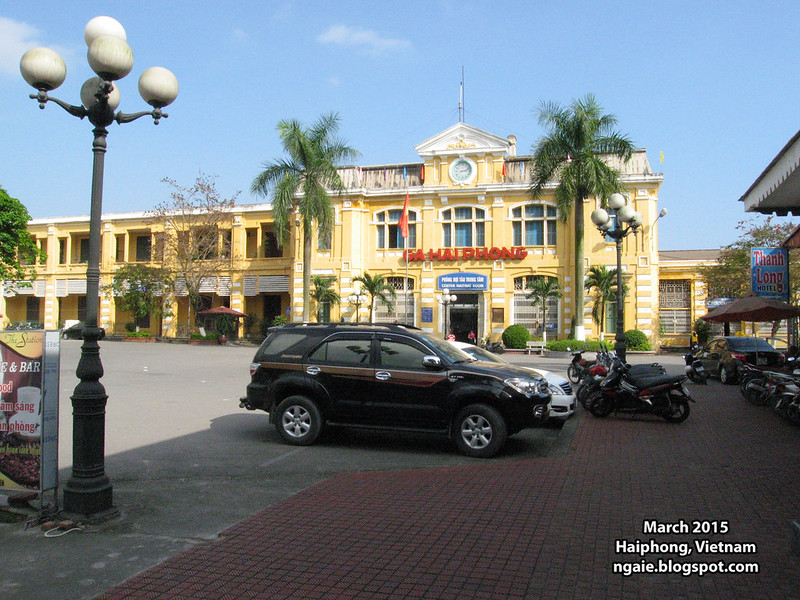
Inside the station from another era.
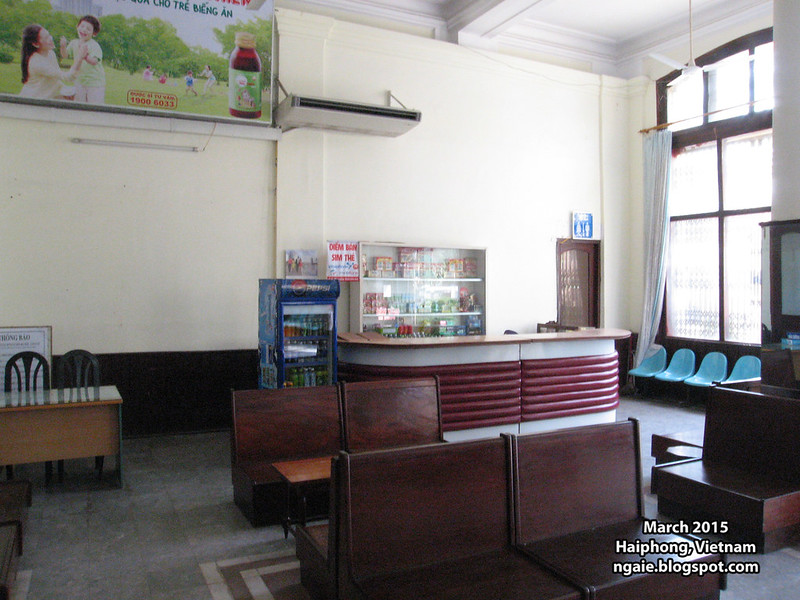
Street shops.

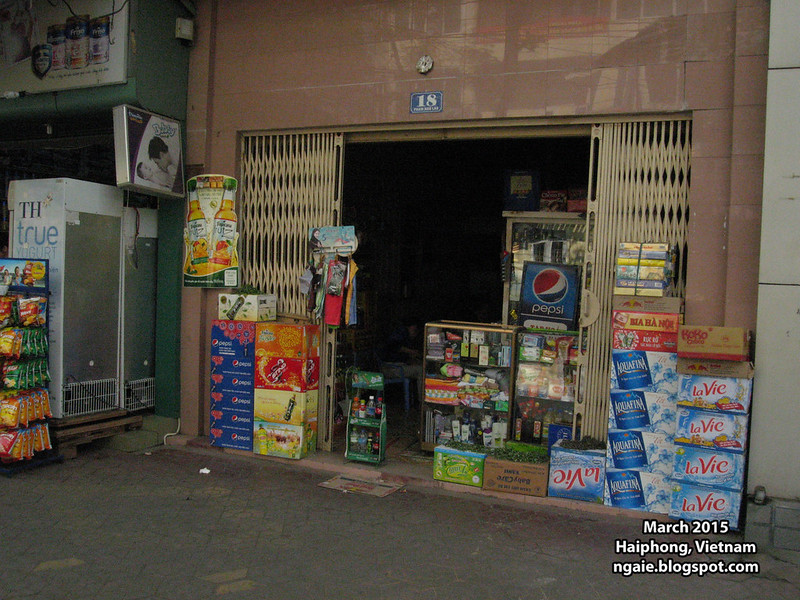
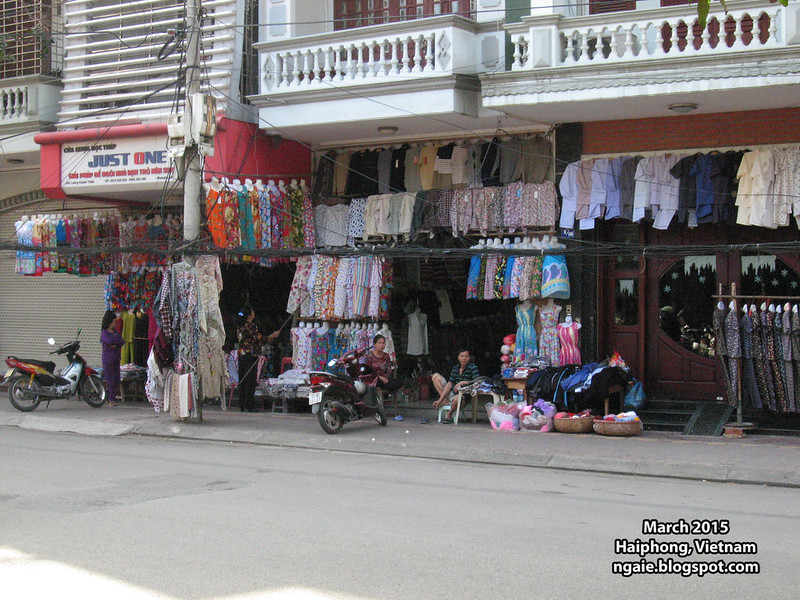
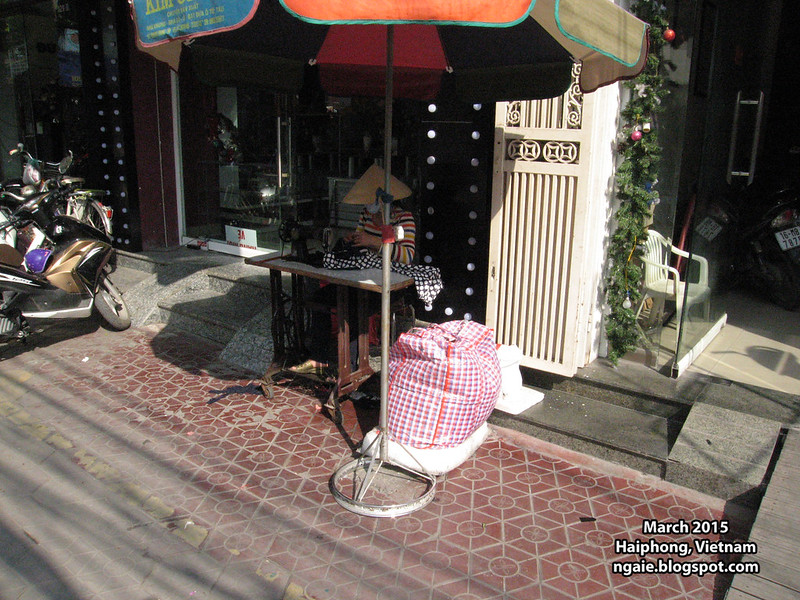
Roadside fruit vendors.
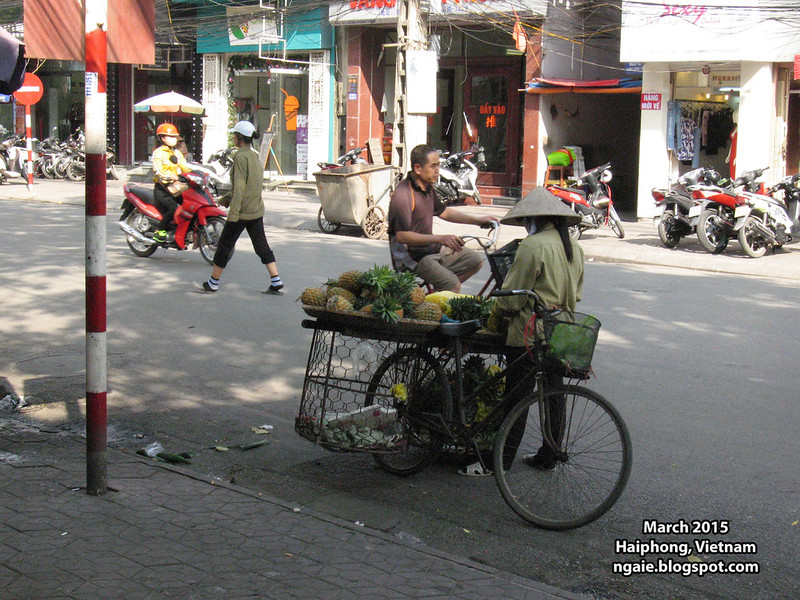
Live chickens for sale.
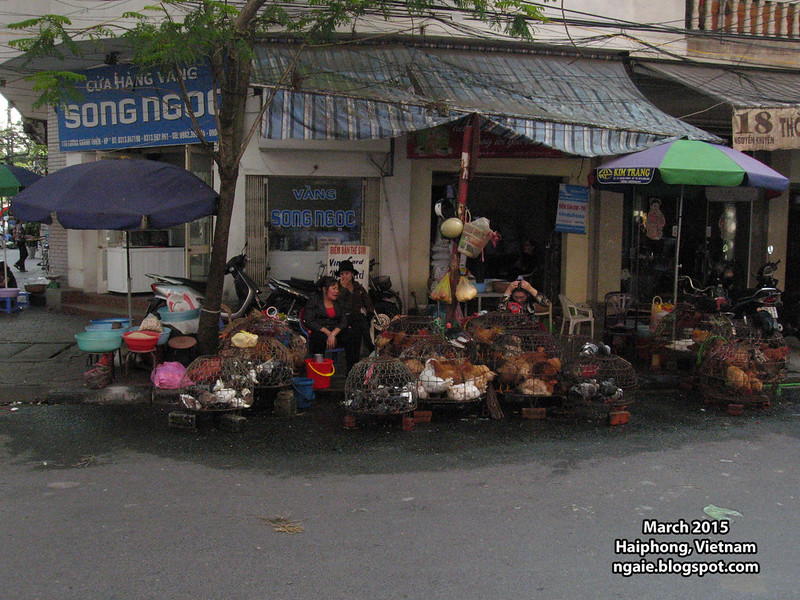
One of the main wet markets.
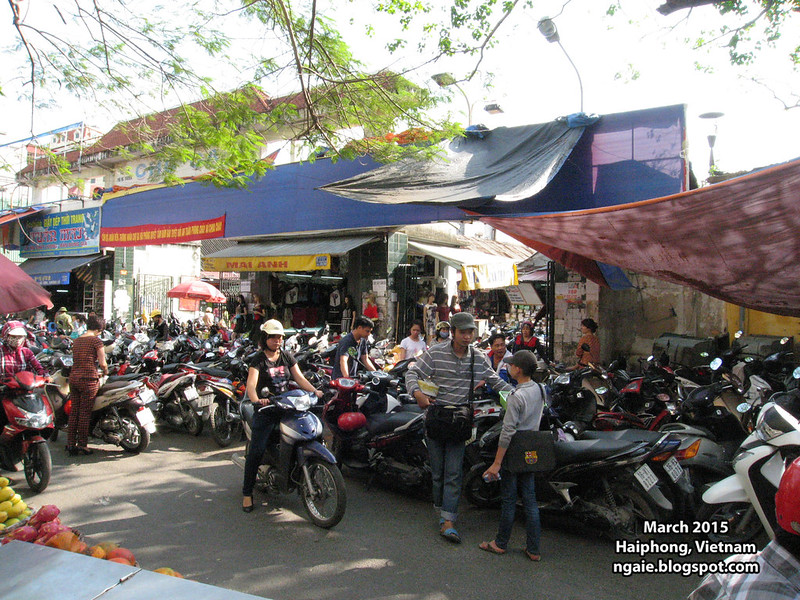
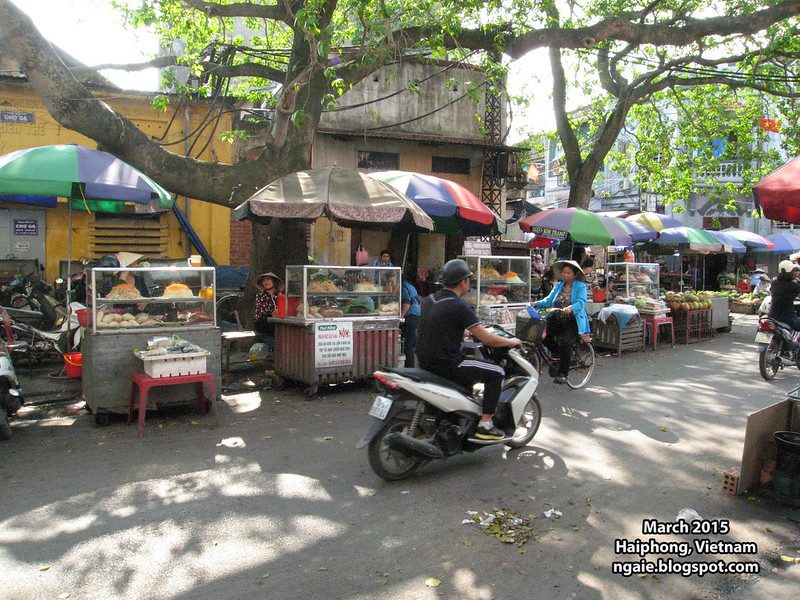
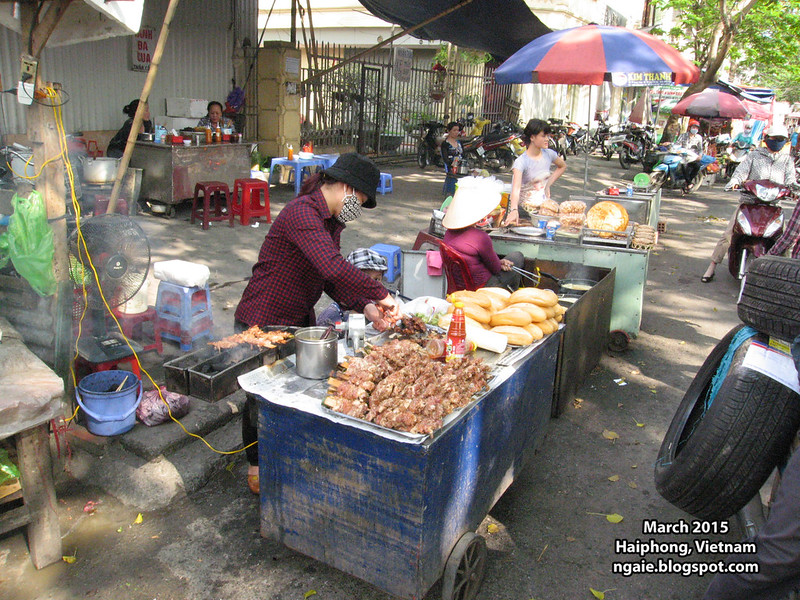
So fresh and so cheap.


Guy in an army helmet carrying construction materials on his bicycle-powered cart.
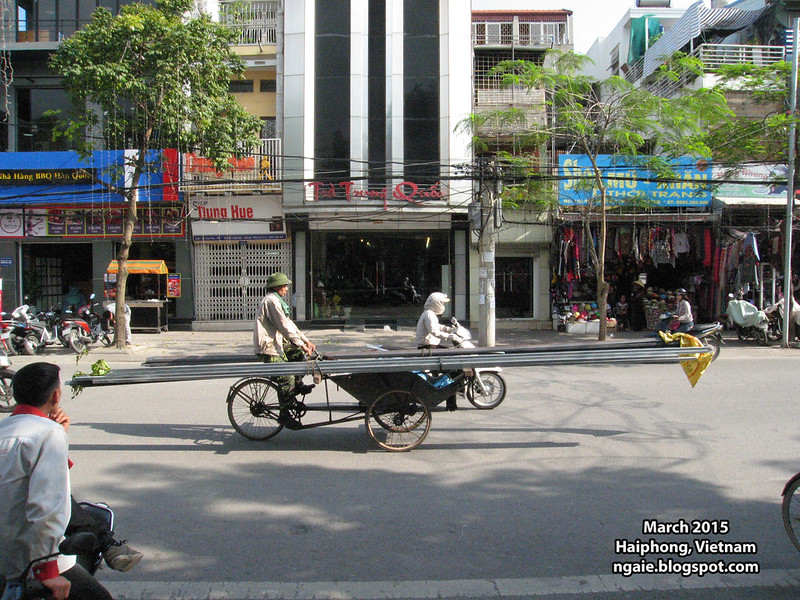
Typical commercial street.
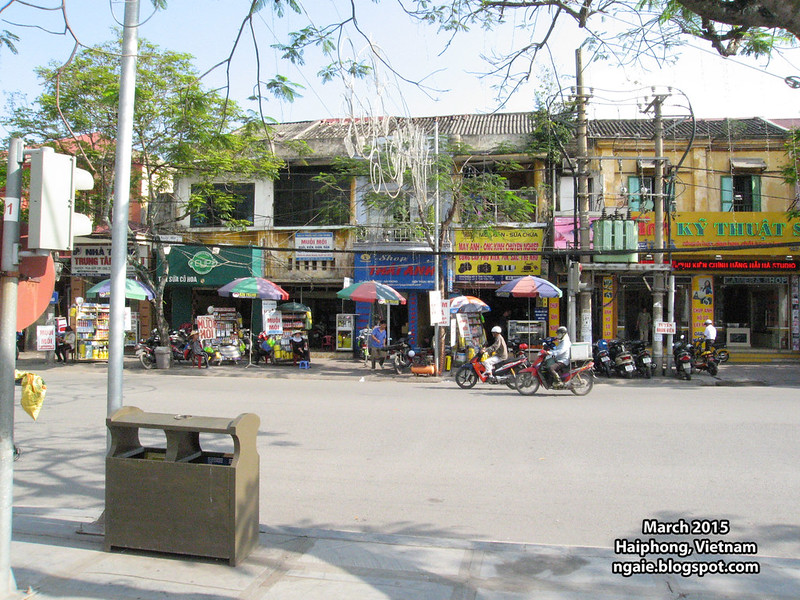
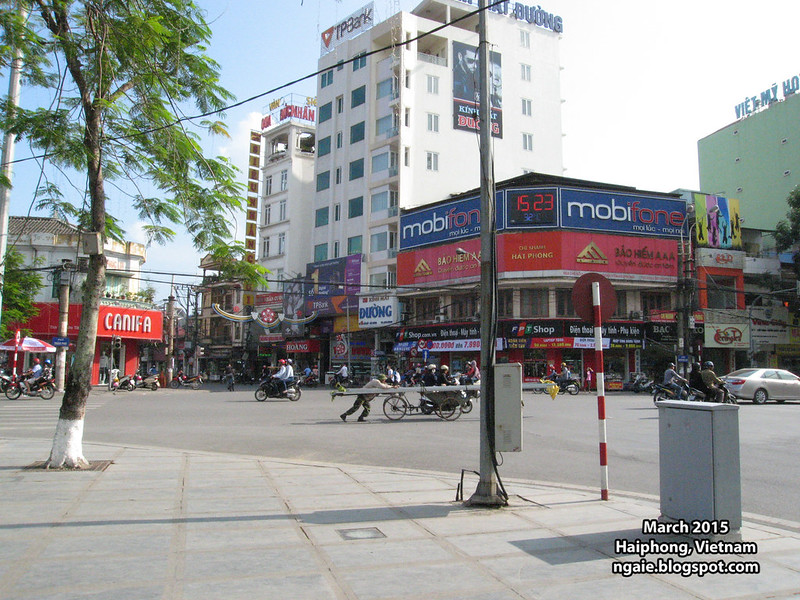
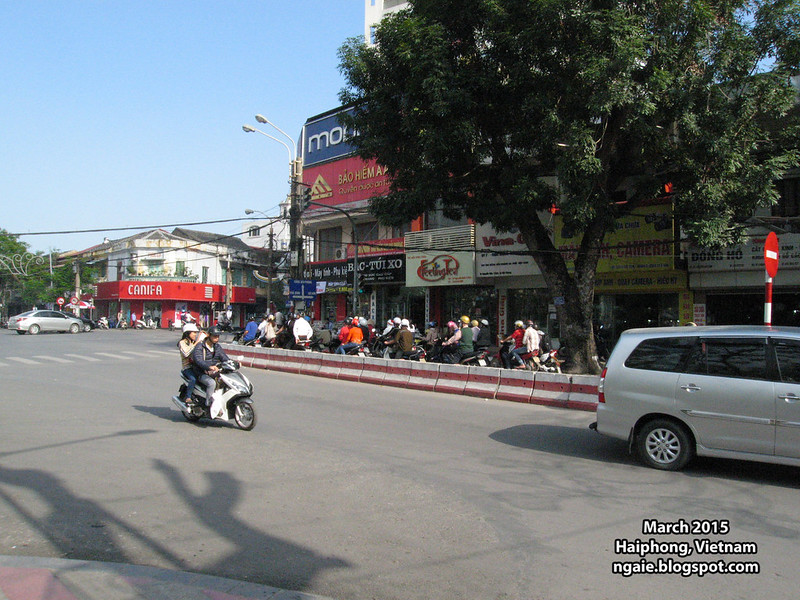
Household goods market.
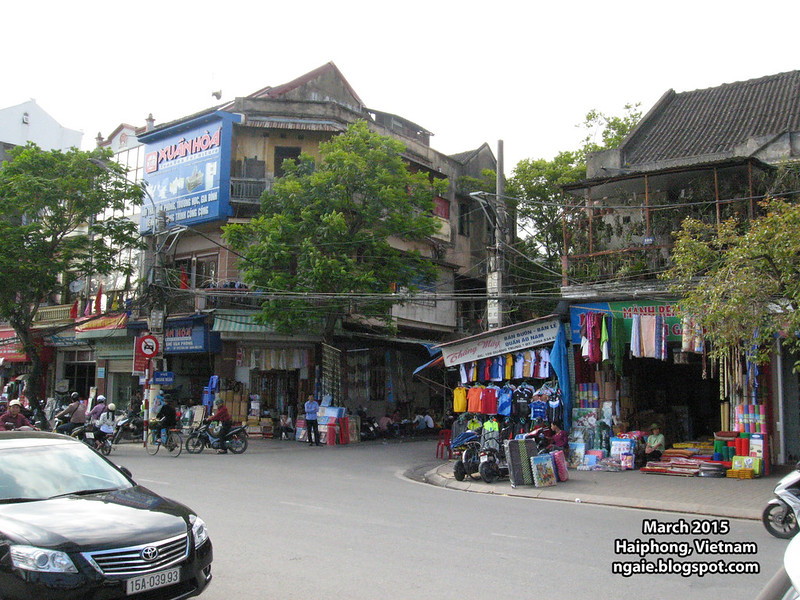
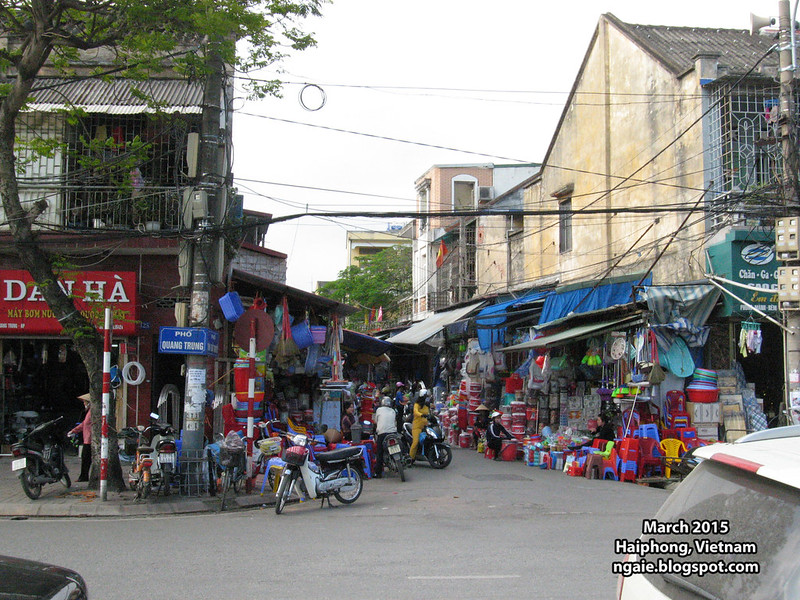
Toy shop.
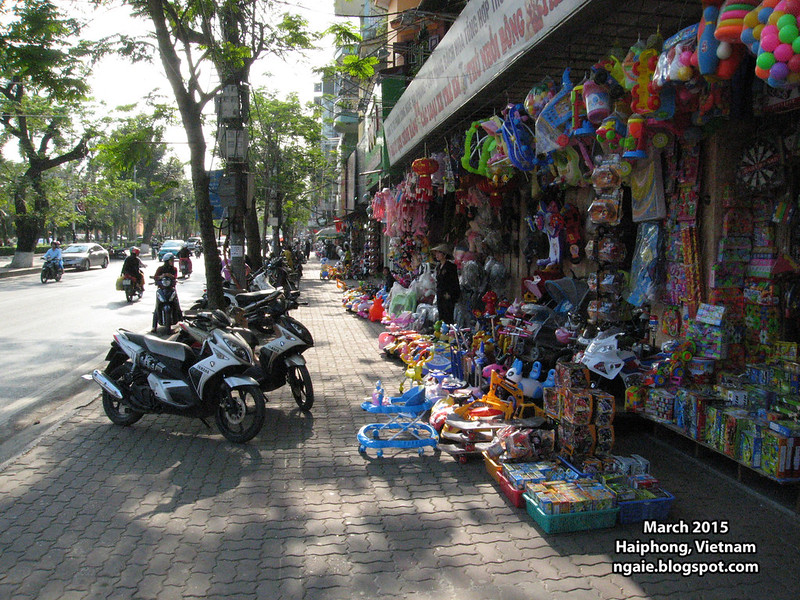
Remnants of the French colonial era. The Catholic church.
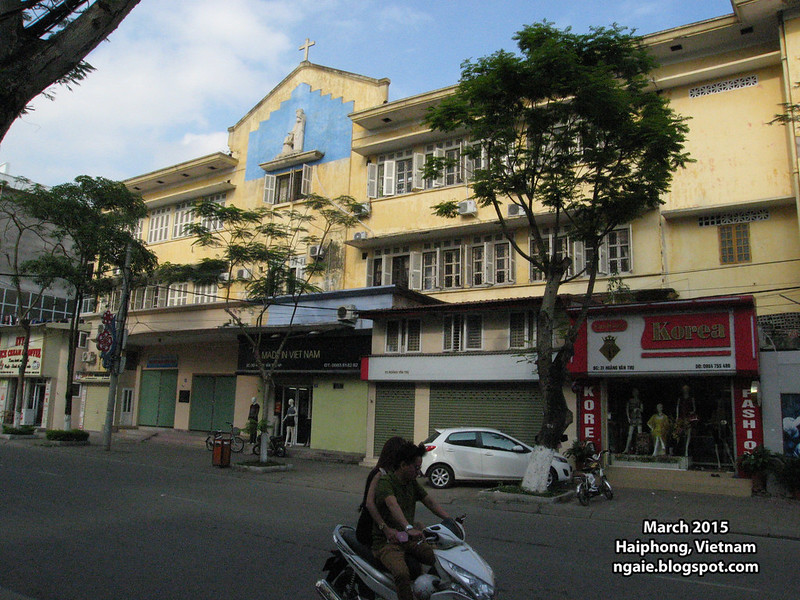
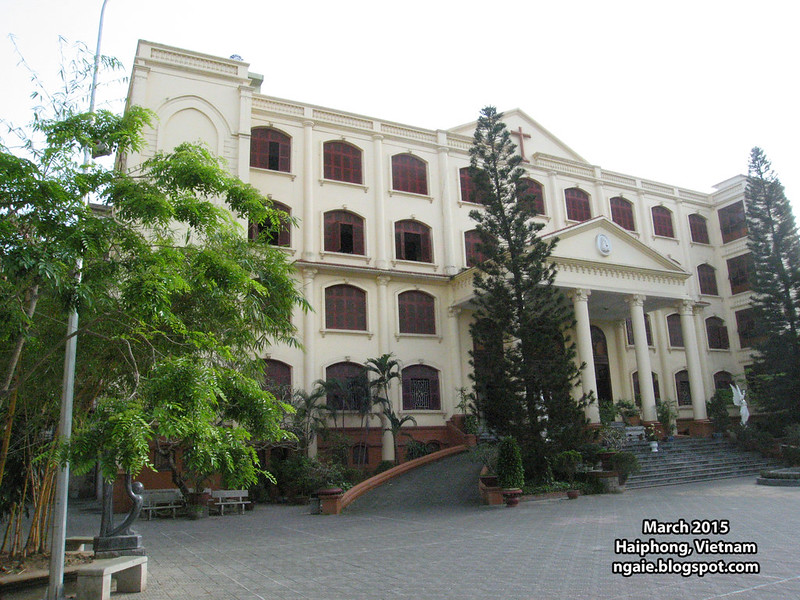
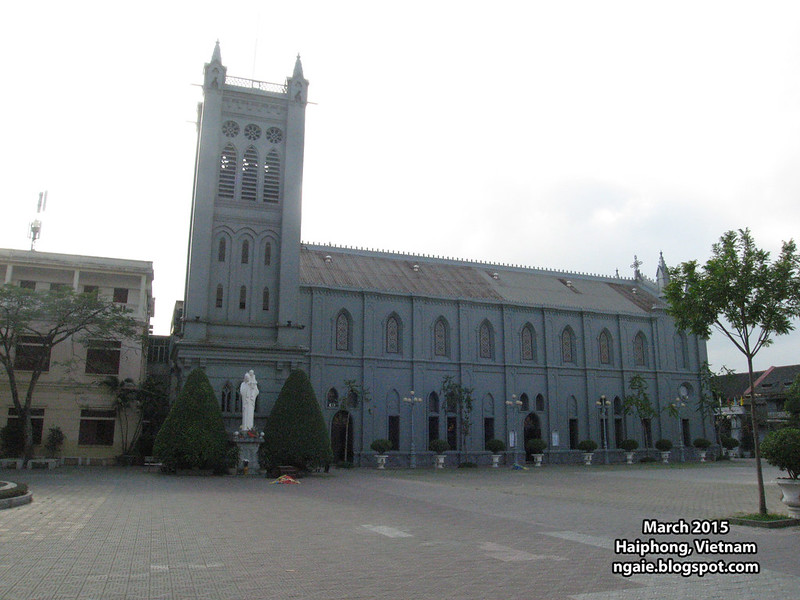
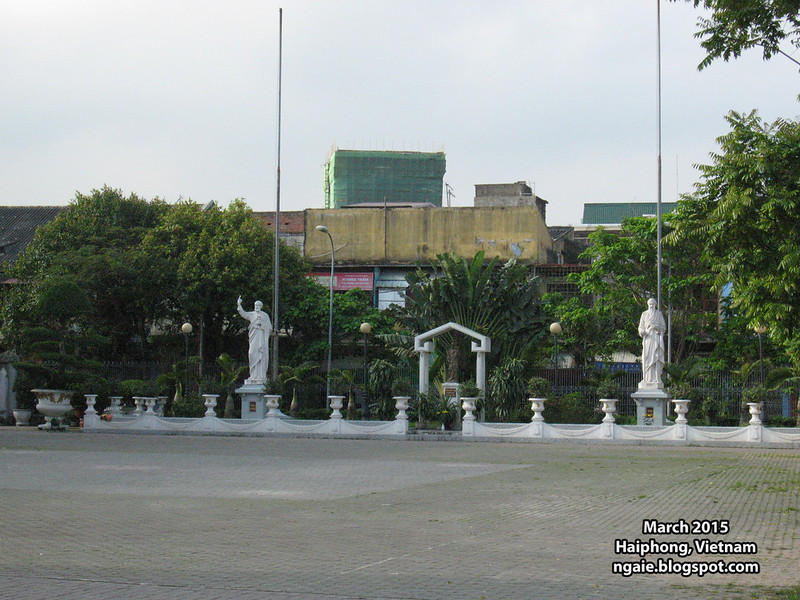
Decaying French style buildings around the old French colonial administrative area.
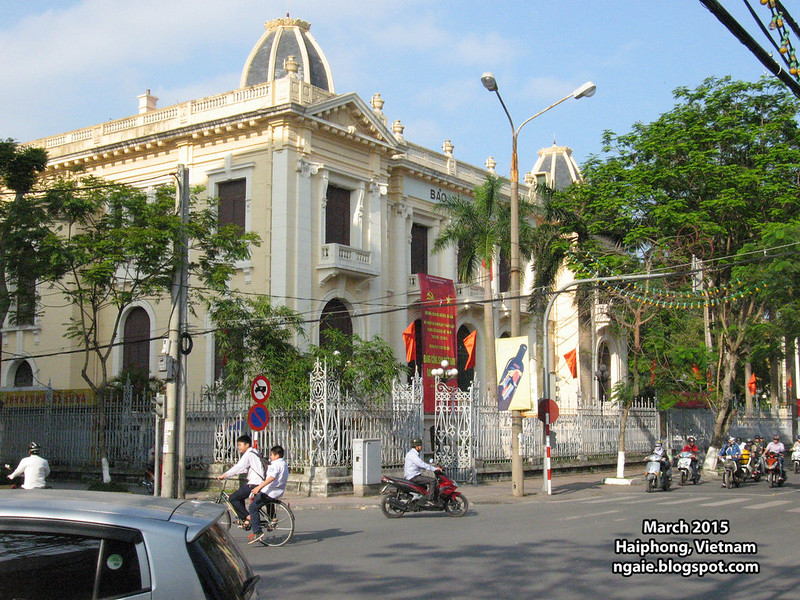
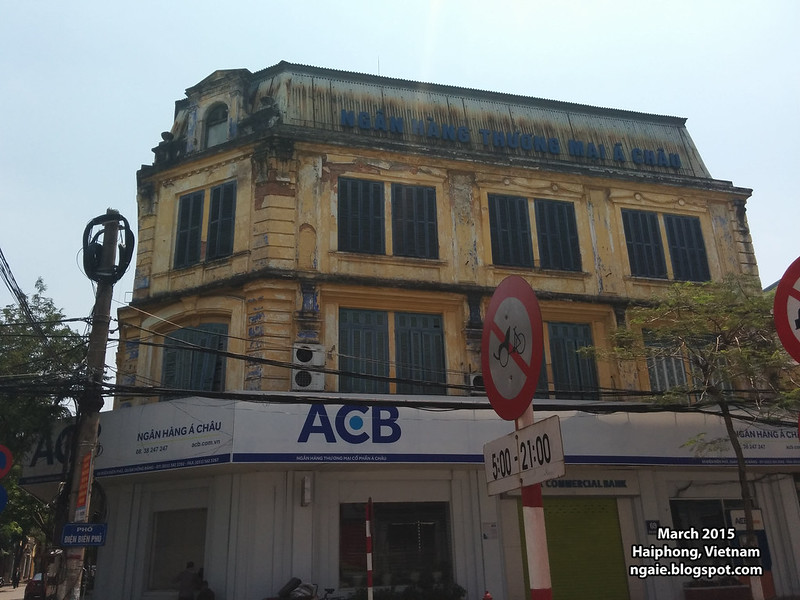
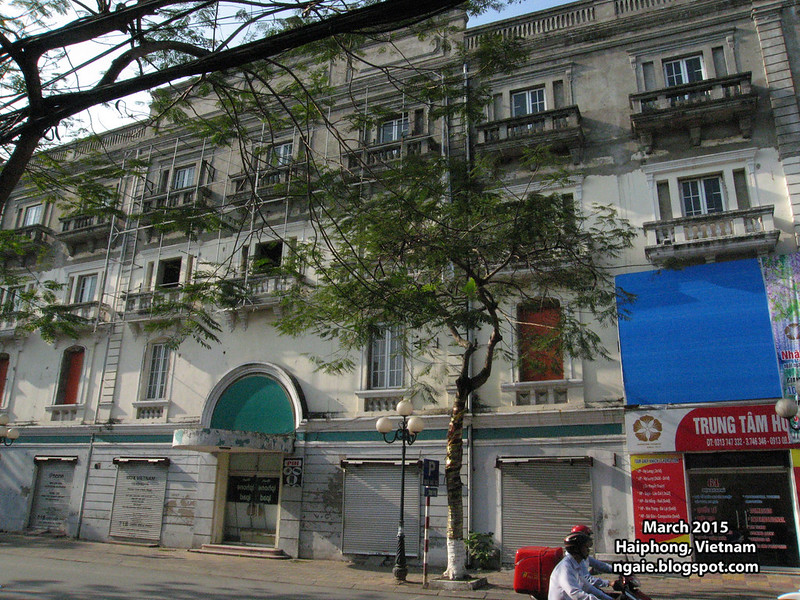
The old French colonial administrative area, now occupied by Vietnamese government offices.
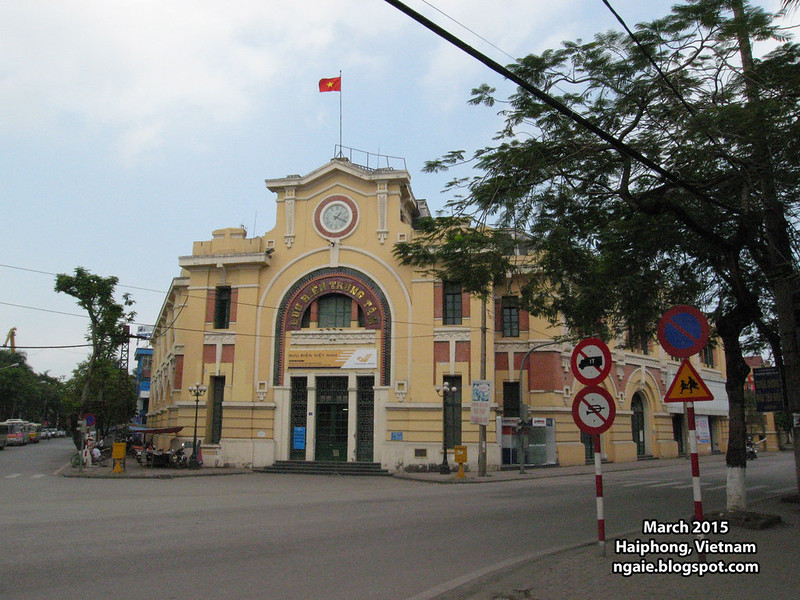

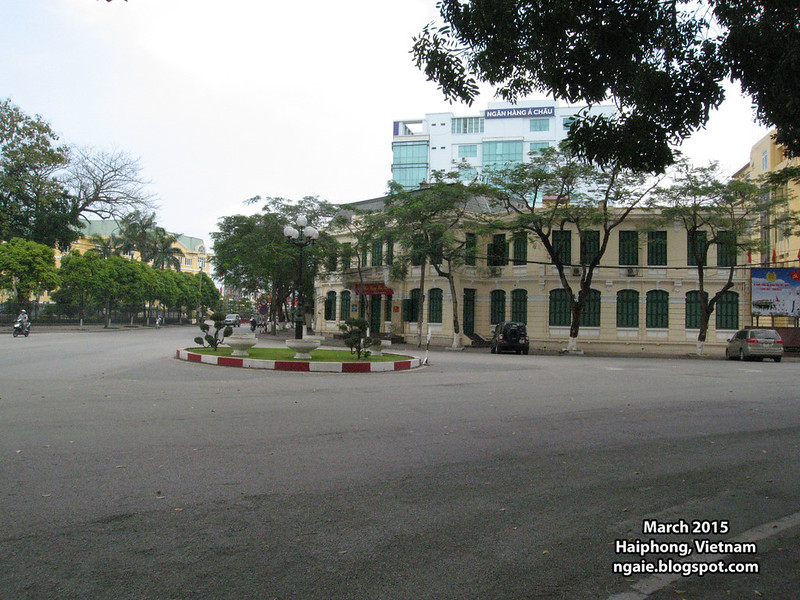
Abandoned construction.
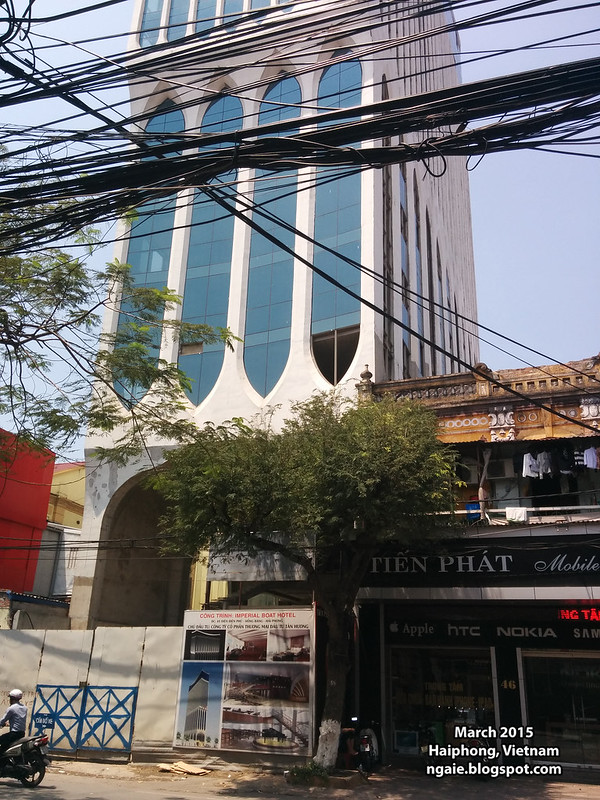
Railway tracks that bisect a roundabout. When one of the few passenger trains in the day pass through here, traffic grinds to a halt in all directions.
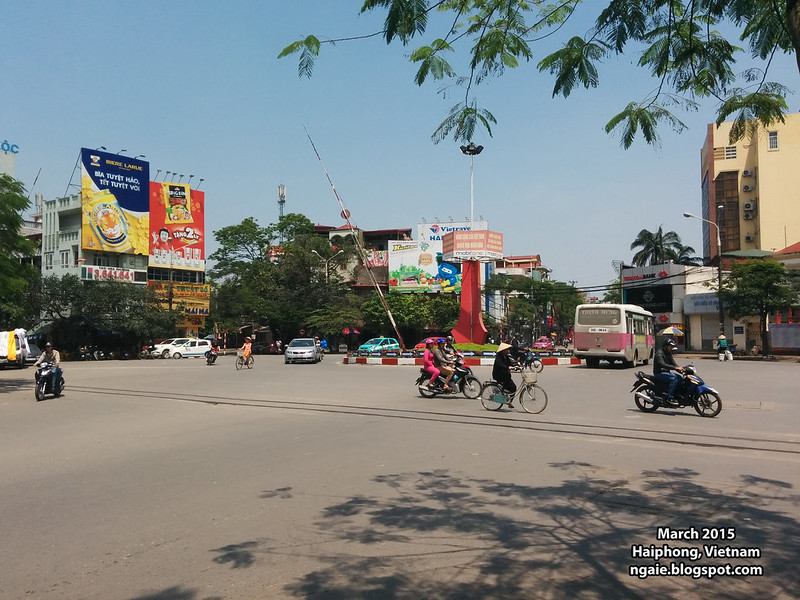
In Haiphong, there were maybe 5-6 restaurants that were foreign friendly (i.e., they had English menus) and one of them was this Pizza Hut. Needless to say, I had never eaten Pizza Hut so many times in a period of around 30 days before. (Note: Never ever order pasta at Pizza Hut, it tastes just like frozen microwaved pasta)
Above the Pizza Hut, there was a stylish Vietnamese cafe and we often ate lunch there.
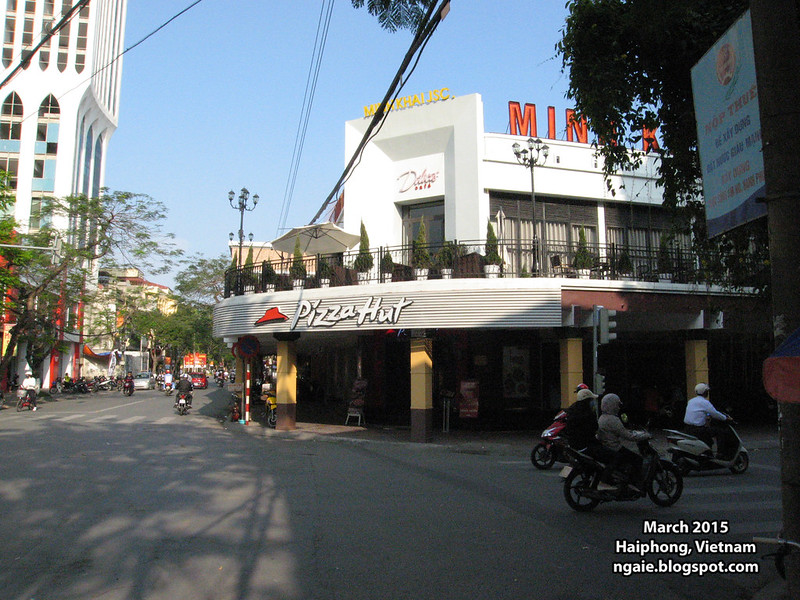
A typical lunch set from that upstairs Vietnamese cafe that included a side dish, rice and soup. It only cost around 40,000 VND to 60,000 VND (US$1.70-2.69). I actually wanted to eat pho a lot of times, but actually in Vietnam, pho is considered a breakfast meal so it was not usually served during the lunch time.
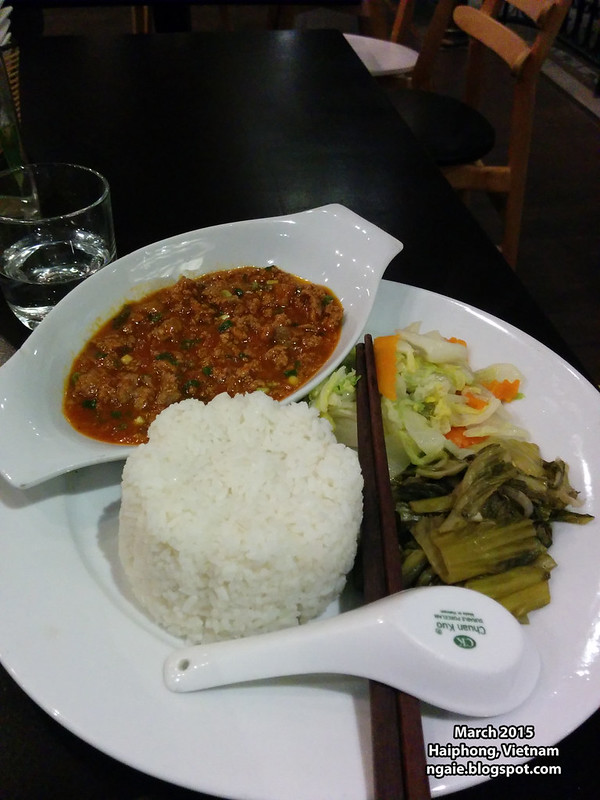
Another place that I often went to was a restaurant called "Texas BBQ" that served American food. I have no idea why such a restaurant existed here but it was quite decent and the portions were "Texas-sized".
Nachos.
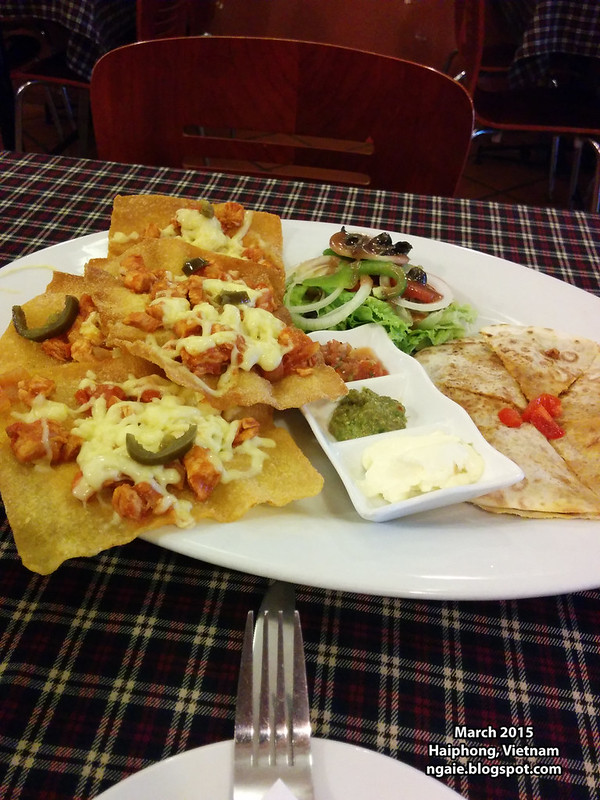
Ribs. I had never seen ribs served with the meat stabbed with a knife before!
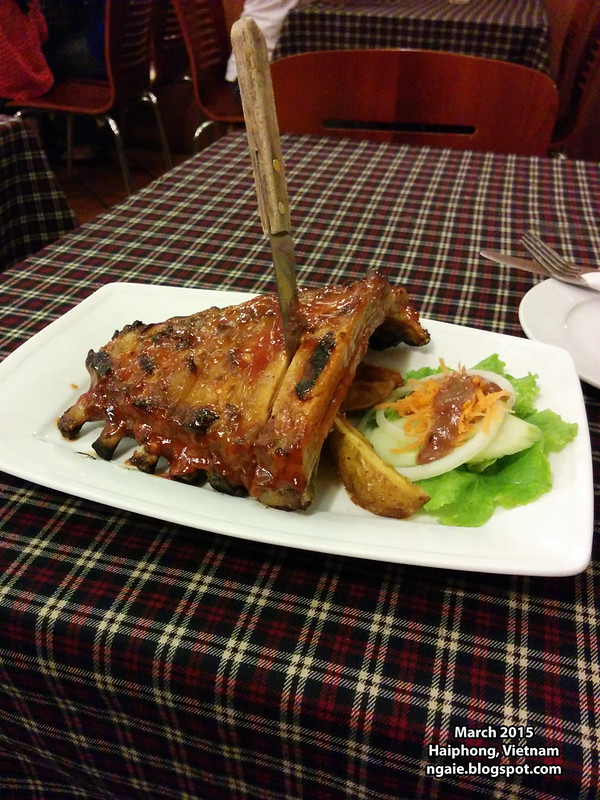
In all the restaurants, all the napkins are meticulously folded into a shape of a lotus, Vietnam's national flower.
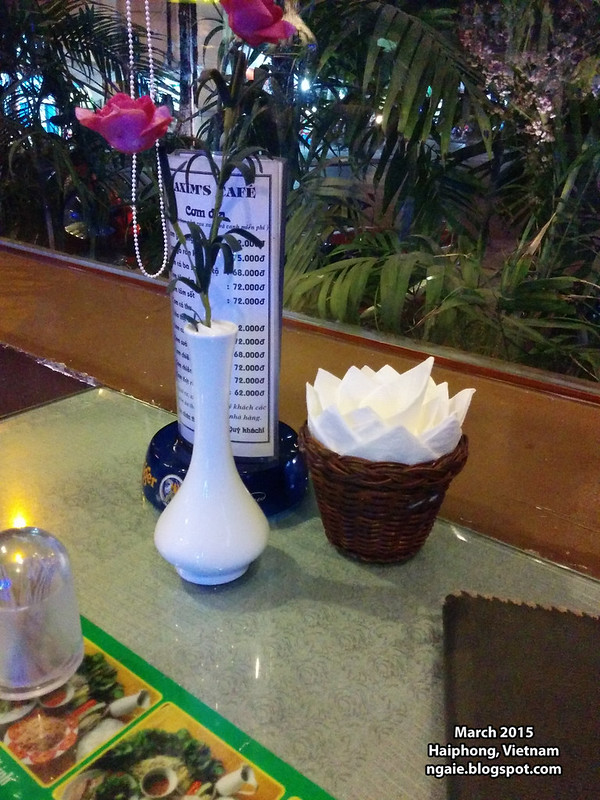
In addition, I also had some local food from Haiphong. Apparently what was famous in Haiphong was not pho, but rather, "banh da cua", Haiphong crab noodles where the soup is seafood based. Personally, I prefer the beef-based pho instead. At this meal, there were also generous servings of giant ball-sized fried spring rolls which were delicious.
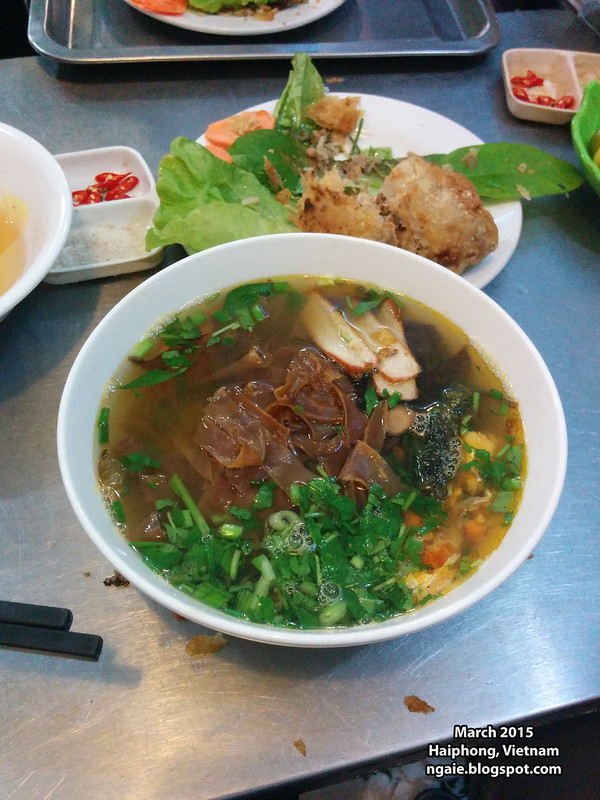
A local staff also recommended a "traditional style" Vietnamese restaurant to me and I didn't know it was an upscale place until I saw the menu. Anyways, what I ordered turned out to be disappointing.
This tasted like fried fish with tartar sauce, except with a hint of Vietnamese-ness.
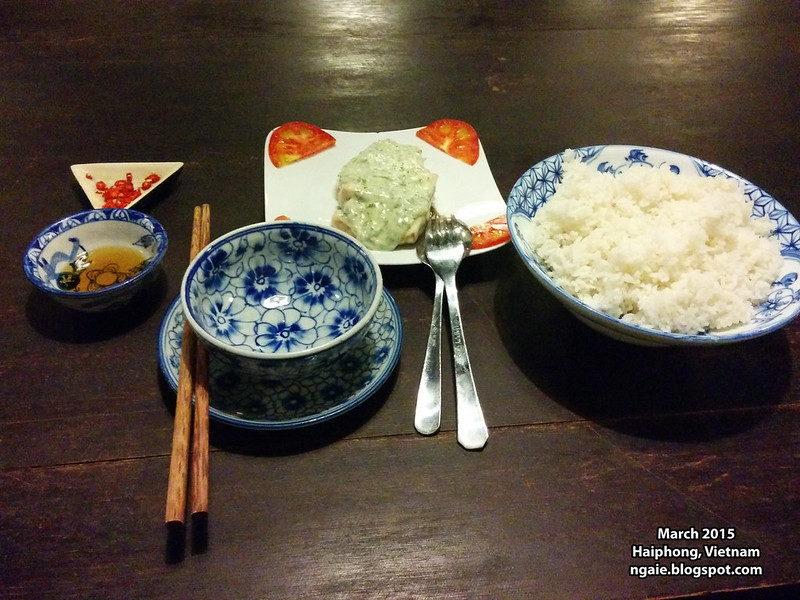
Lemongrass chicken, nothing really special, except for the price.
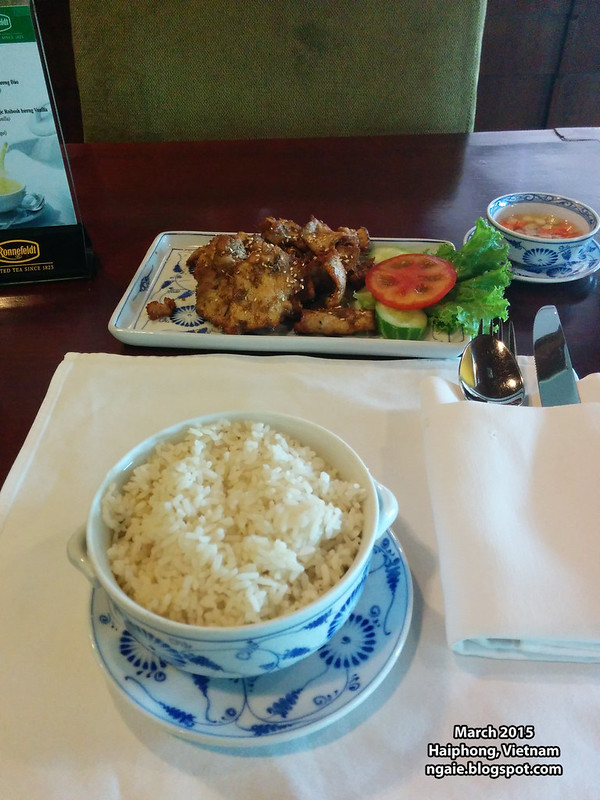
I walked by this street hawker almost everyday while I was there because it was on the road from the hotel to the Pizza Hut area with restaurants. Unlike most street hawkers, the guy who runs this place also manages to plug in a big screen TV for his customers that was connected to a satellite dish that he just places on the sidewalk!
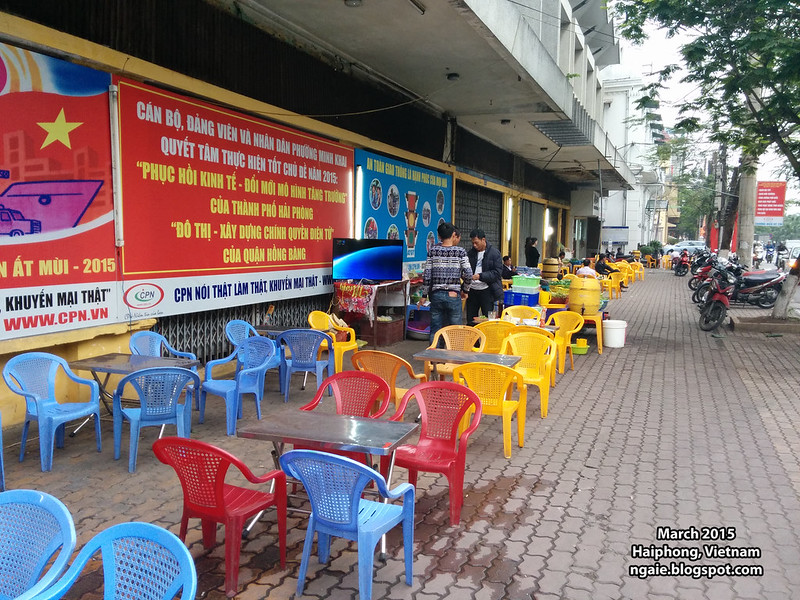
Local weekend leisure activities at the park, cock fighting?
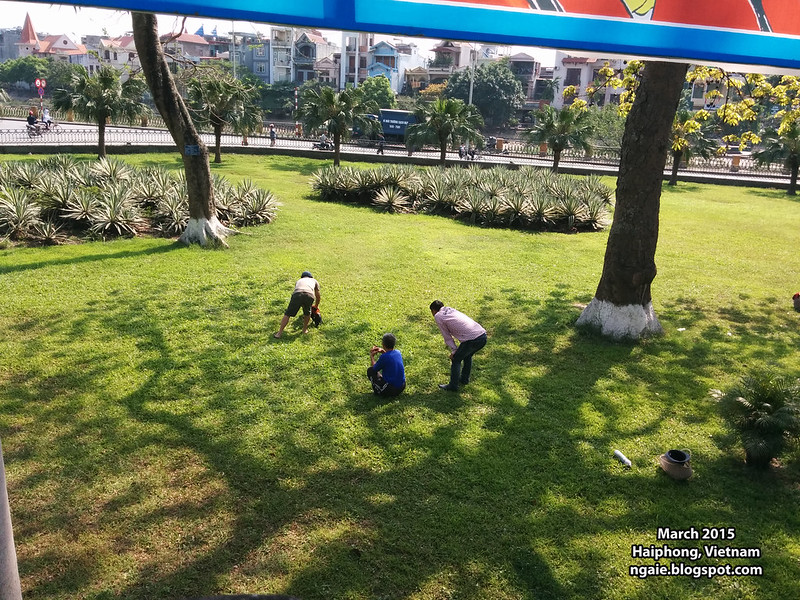
April 14, 2015 was the day of my flight back to Tokyo and since all flights from Southeast Asia to Japan are red eye for some reason, I decided to spend one day checking out Hanoi.
While I was heading west to Hanoi, another project team member had just landed in Hanoi from Japan and was going eastbound towards Haiphong. Instead of my Haiphong-based driver driving me directly to Hanoi, we rendezvoused with the Hanoi-based driver who was driving the project team member east. The cars pulled off at the side of the highway and we switched cars. I was quite surprised that they did this because no one told me that we were going to switch drivers in the middle of the journey!
I was quite surprised to see that Hanoi was still a low-rise city except for a few tall buildings. Its nice to see an Asian city that is still predominately low-rise and still has its own character. I wonder if Hanoi will be transformed into a typical generic Asian megacity full of banal glass and steel high rises as its economy continues to develop.
The skyline of Hanoi as seen from crossing the bridge and entering the city proper.
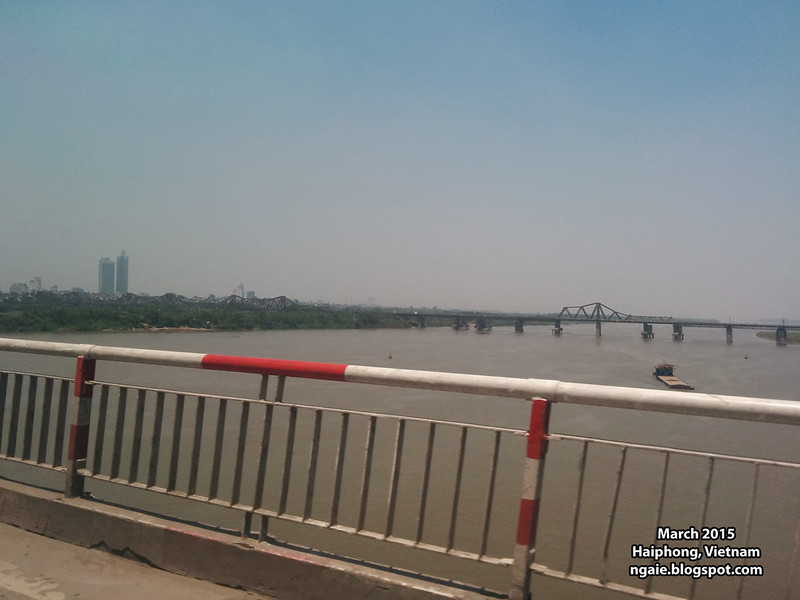
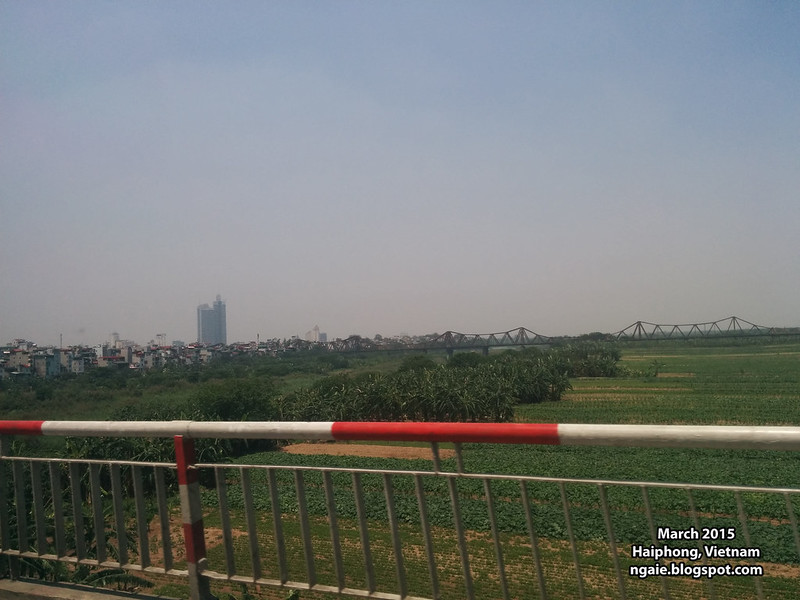
By the time I reached Hanoi, it was already lunchtime, so I had researched some famous pho restaurants in advance and I asked the driver to take me to them to try the northern Vietnamese-style pho. In an article by the Wall Street Journal about the famous pho restaurants of Hanoi, they recommended a place called "Pho Thin Bo Ho" and said that it was a family establishment which had been open since 1949. What I didn't realize once I got there was that this "restaurant" was literally a hole in the wall eatery. When the driver dropped me off in front of the entrance to the alley, I asked him if he went to the wrong place.
This pho stall was located in an alley that connected the outside street with residences in a courtyard and while I was eating, residents on motorbikes would just speed by through the passageway.
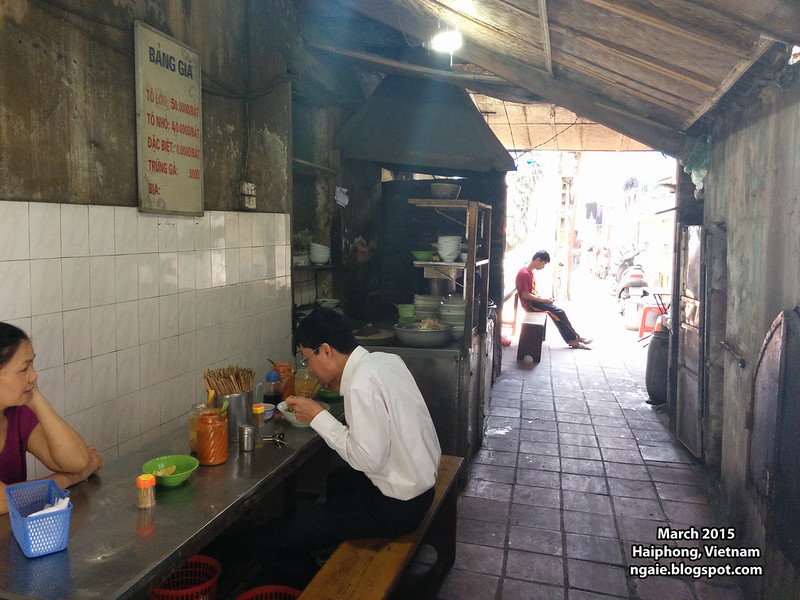
The "kitchen".
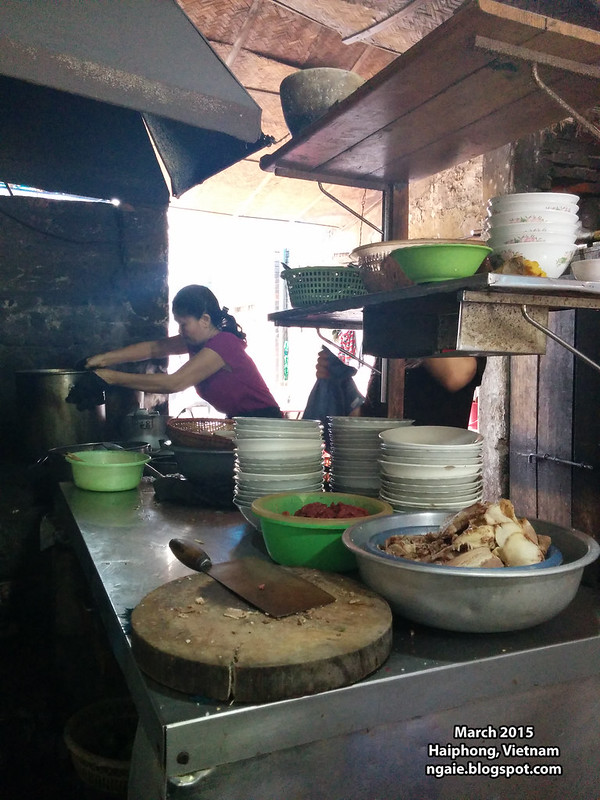
The Hanoi-style pho is less sweet when compared to its southern Saigon-style pho. It was really delicious (I drank all the soup) and it only cost 50,000 VND (US$2.24).
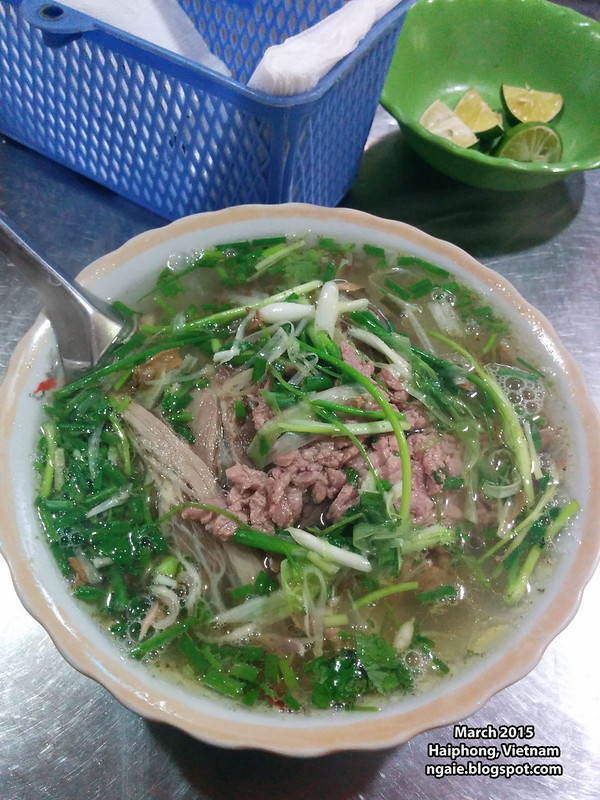
The pho place was located in the ancient Old Quarter of Hanoi and since I had some time to kill before the driver picked me up, I walked a bit around the area.
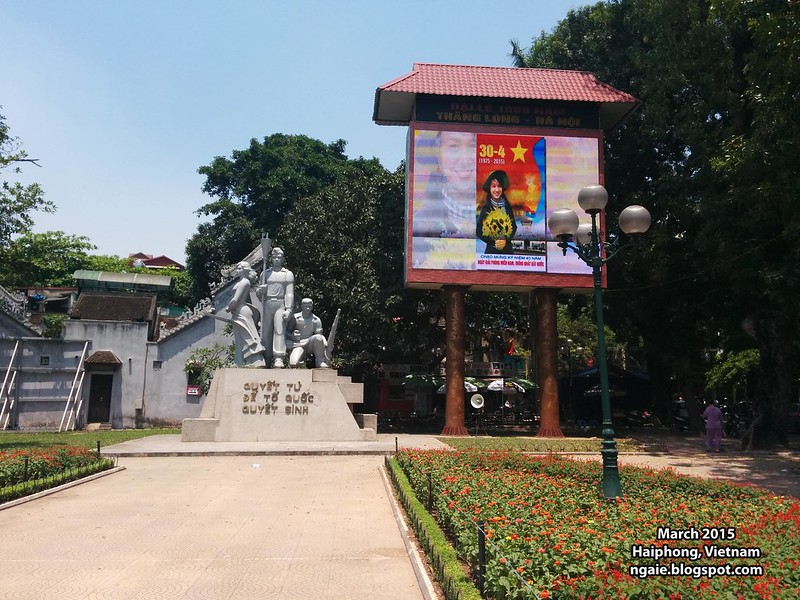
There was a nice lake right in the centre of the Old Quarter with a temple on a small island (very ancient Chinese like). The only other big city that I had been to before in Vietnam was Ho Chi Minh City and in that city, it seemed like there was no historical connection with the past (kind of like what Tokyo feels like today), but in Hanoi, it seemed that I could feel the history and culture of Vietnam.
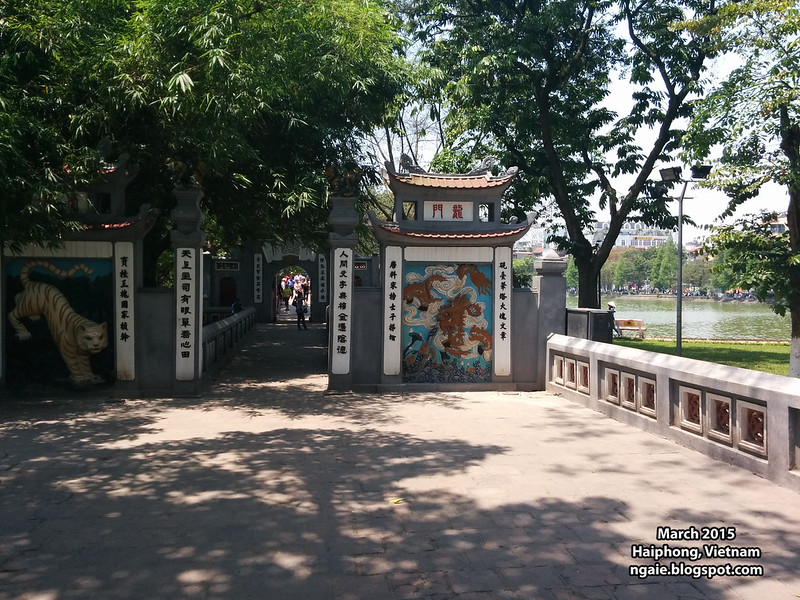
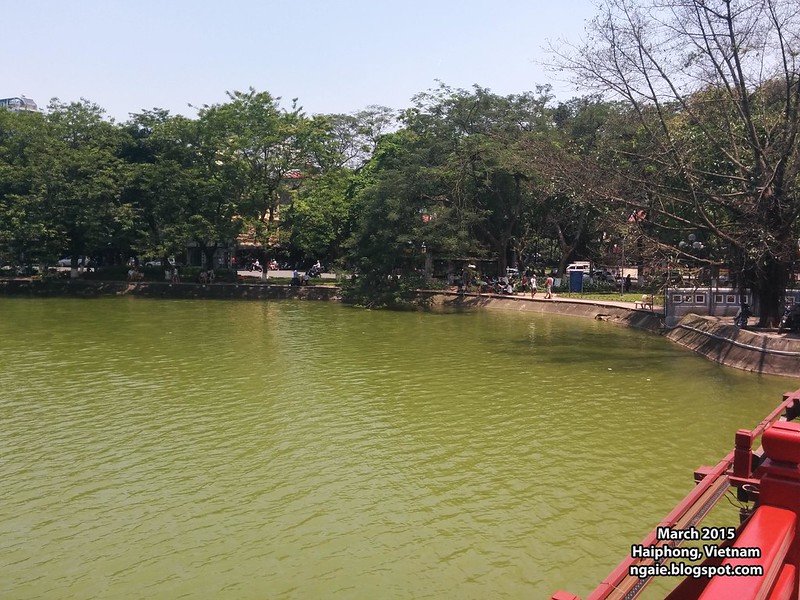
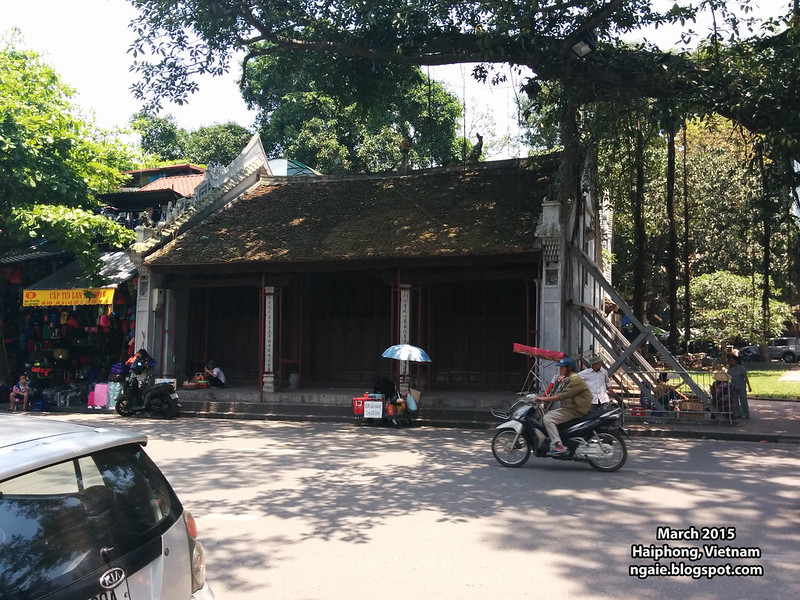
The last place I went to before I had dinner with Vietnamese colleagues and the subsequent flight out of Hanoi was the newly constructed Lotte Tower built by the Korean multinational of the same name. Inside the Lotte Tower was the 5 star Lotte Hotel and their lobby was on one of the top floors of the building so instead of paying the pricey entrance fee to the observation deck, I could view the entire skyline of Hanoi from the lobby of the hotel which had floor to ceiling windows.
From the top, Hanoi looks very European-like.
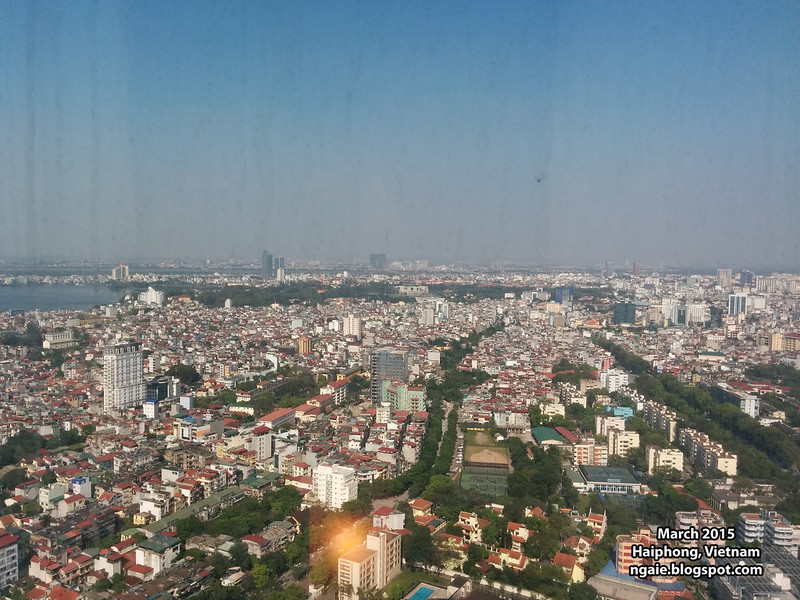
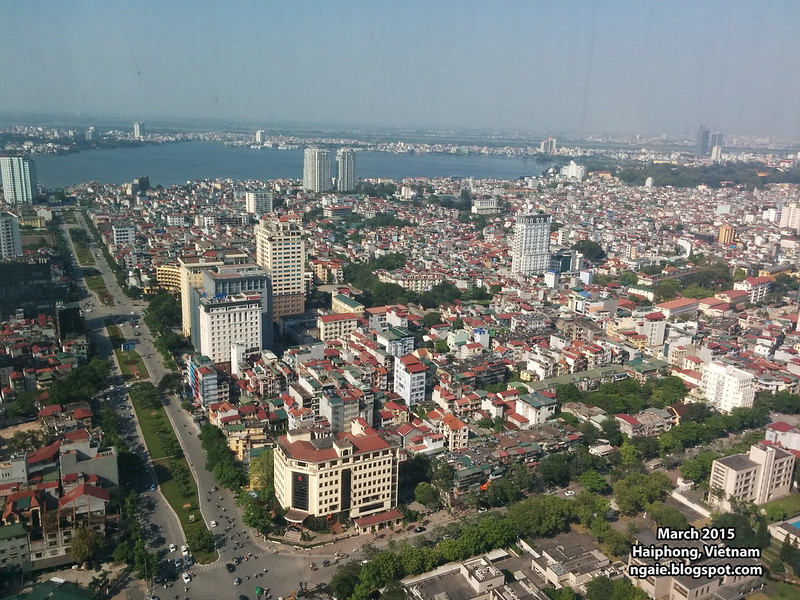
The grey coloured, grim-looking building that is the Japanese embassy, in contrast with the other buildings that all have red roofs.
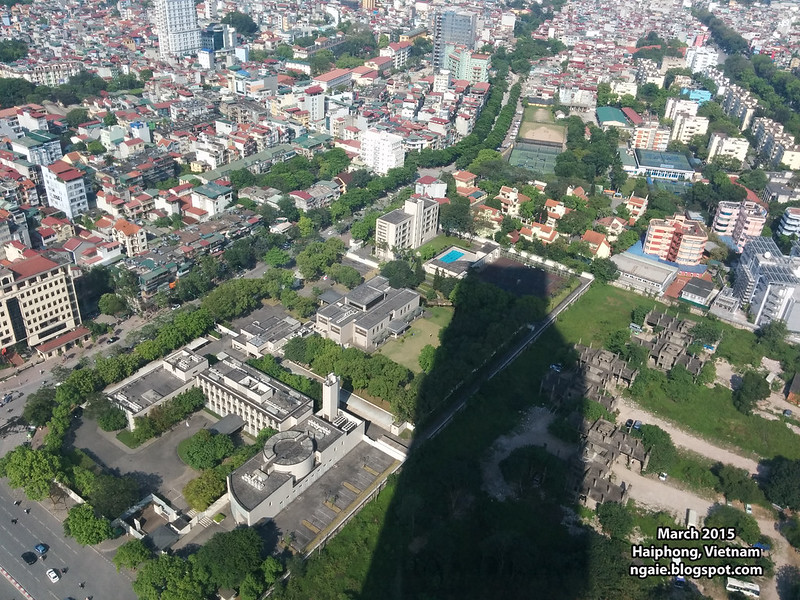

There are so many lakes right in the middle of the city.
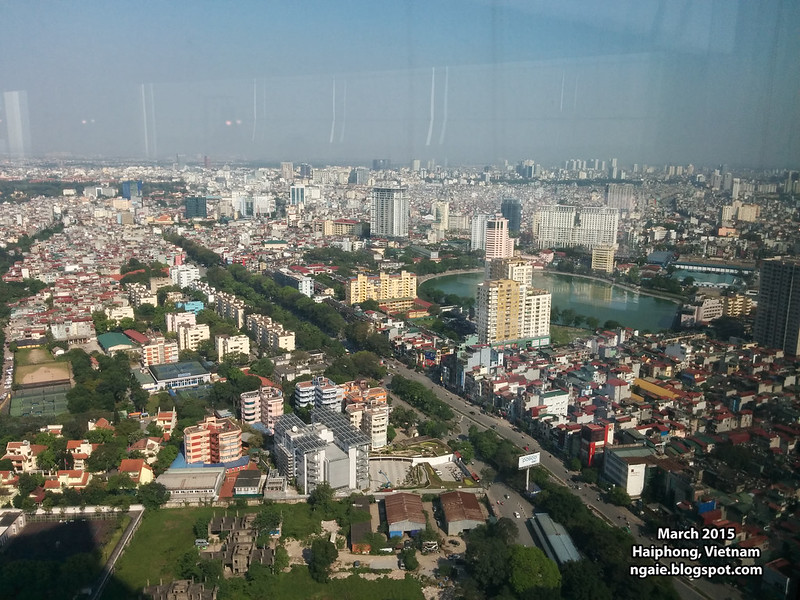
New generic Asian-style "modern buildings".
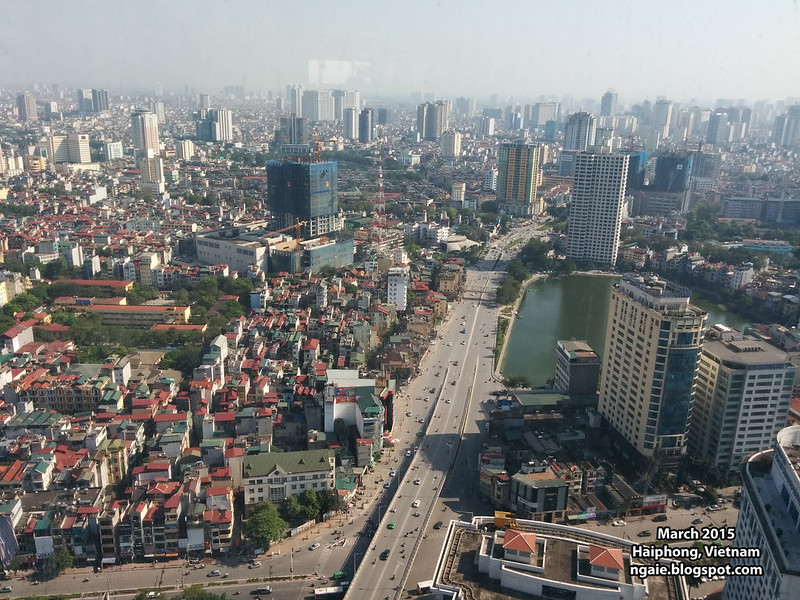
Hanoi airport's new international terminal building which just opened 1-2 months before and it was also built with funding assistance from Japan. It was a nice new building, but again, very generic. I guess this is what happens when the in-house architects from a mega general contractor does the designs. Efficiency and cost over design.
There were many people at the airport, but the check in counters had almost no lineups. This was when I noticed that most of the people were family members sending off their relatives at the airport!
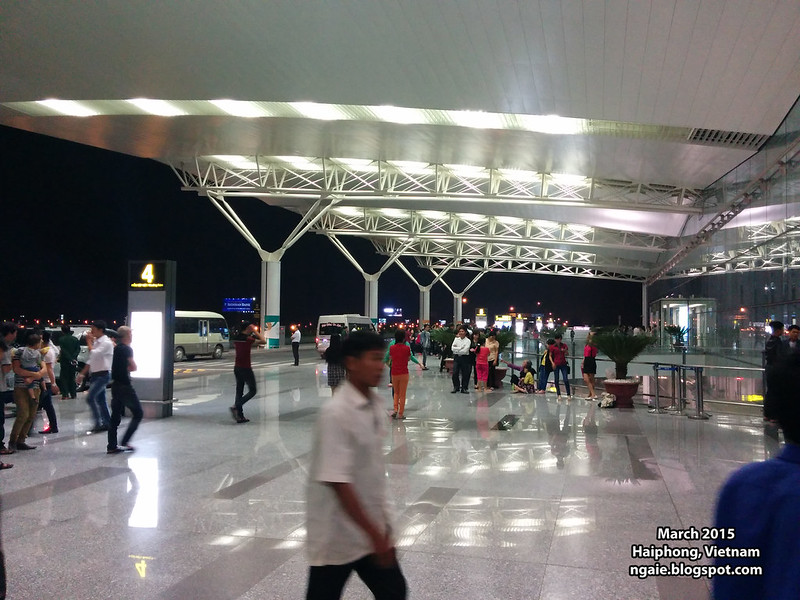


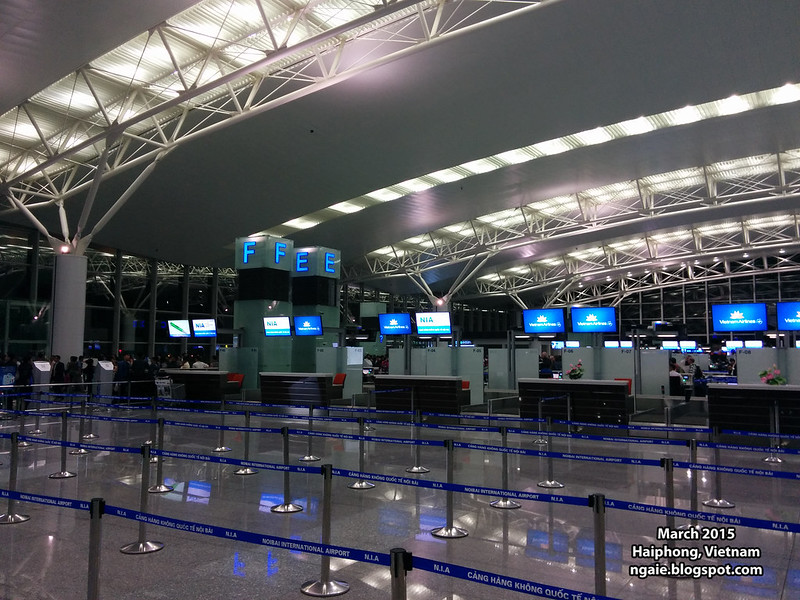
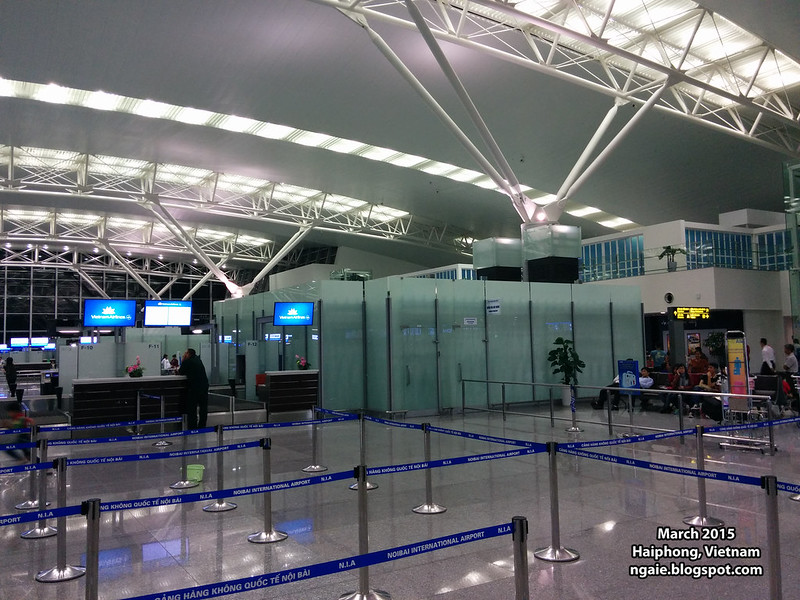
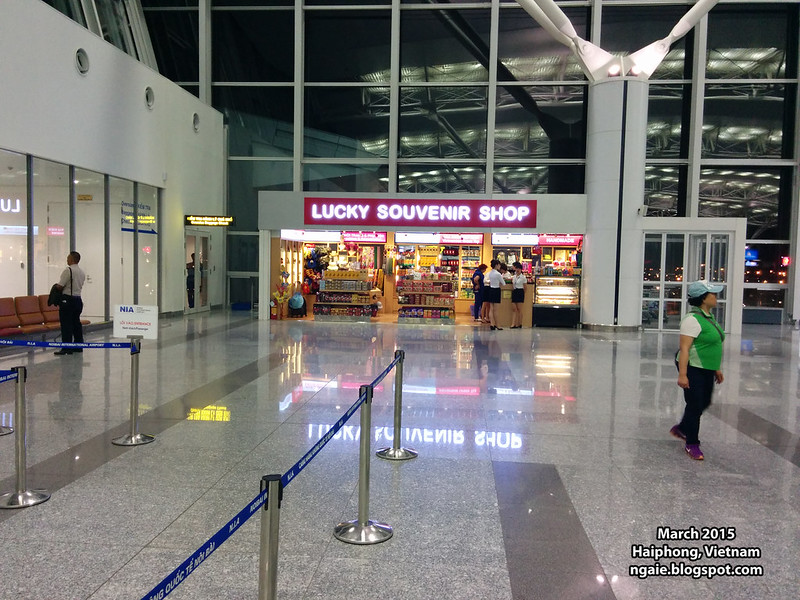
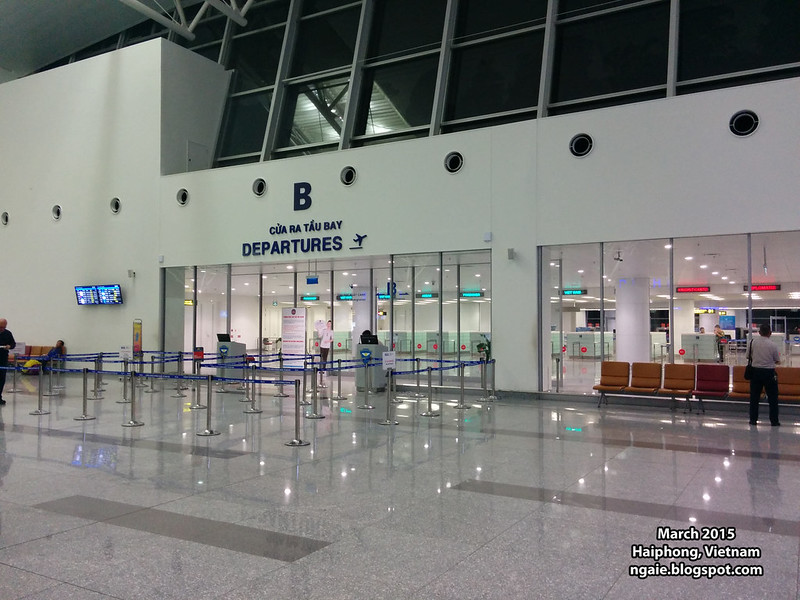
I still had a lot of time to kill before my 12 am flight so I just wondered around and checked out the rest of the building.
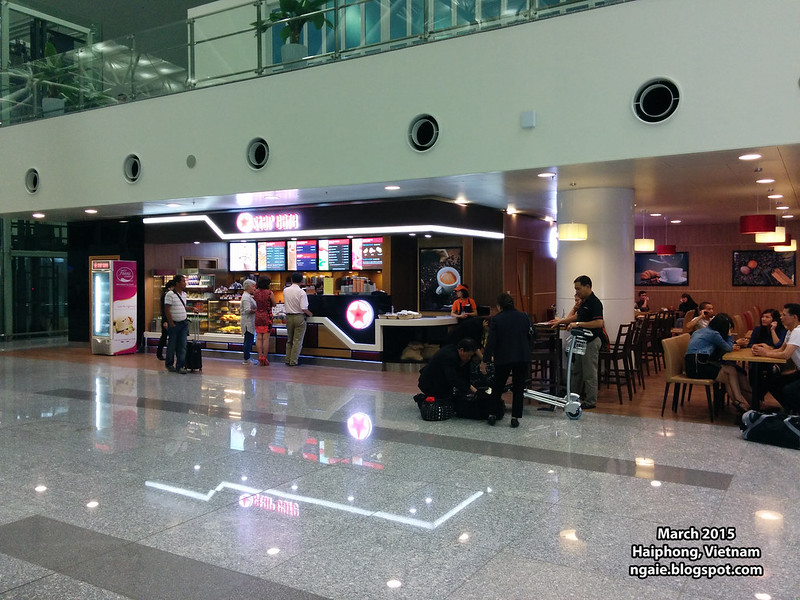
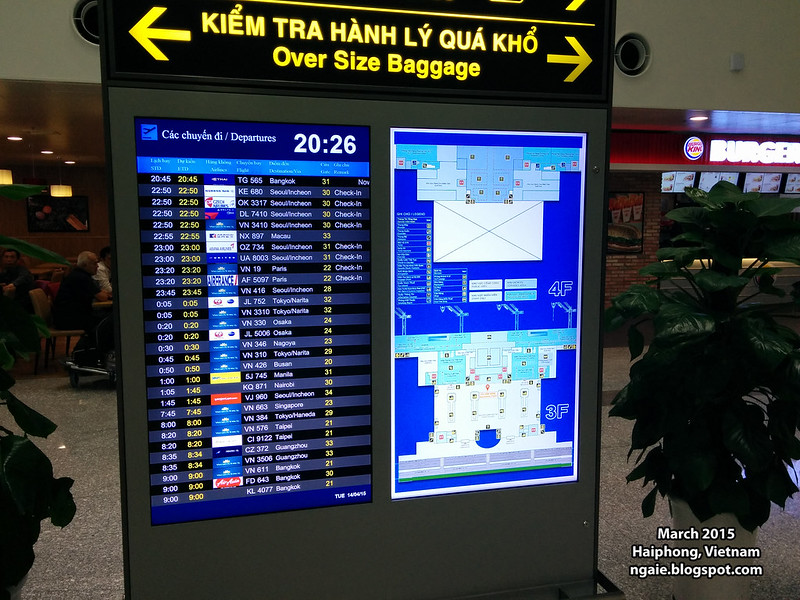
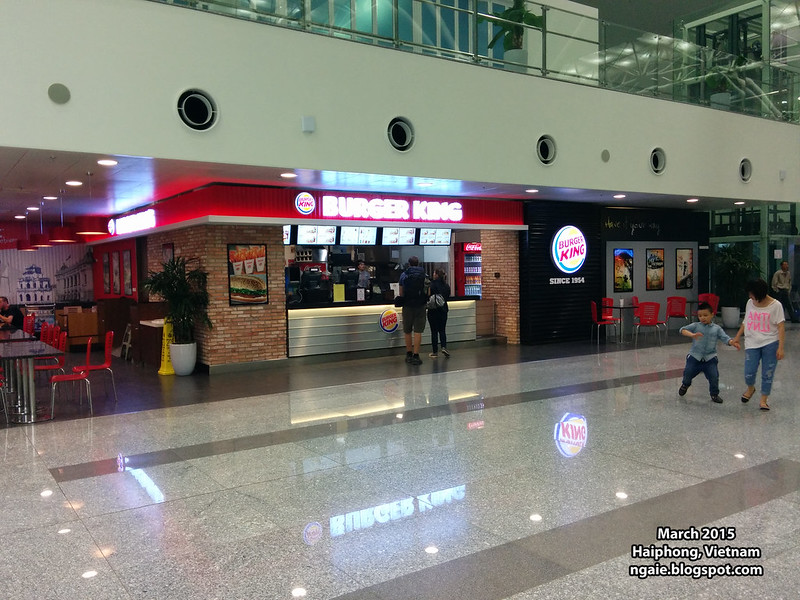
From the second floor restaurants and dining area.

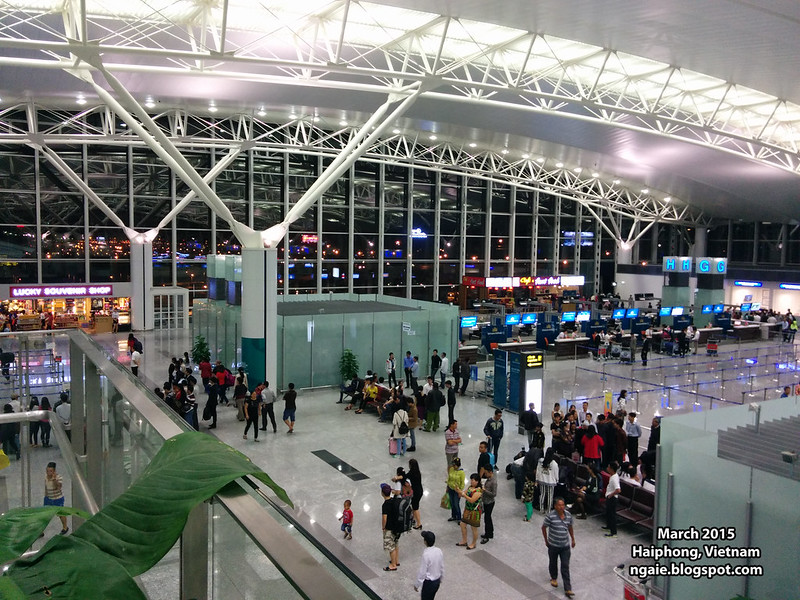
Unfortunately, a lot of shops and restaurants had yet to open.
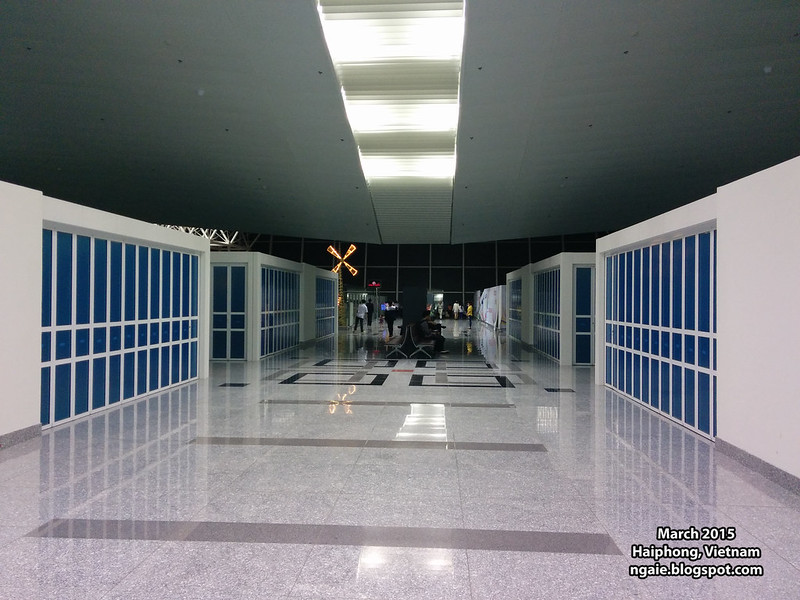
Packed crowds gathered at the windows to see the airplanes take off from the runway.

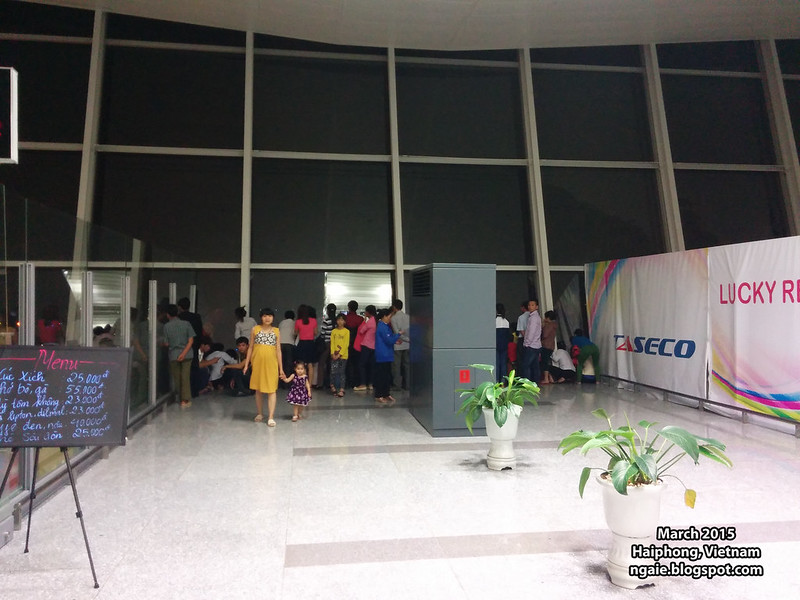
The middle floor between the departure floor and the arrival floor. Still waiting for tenants.

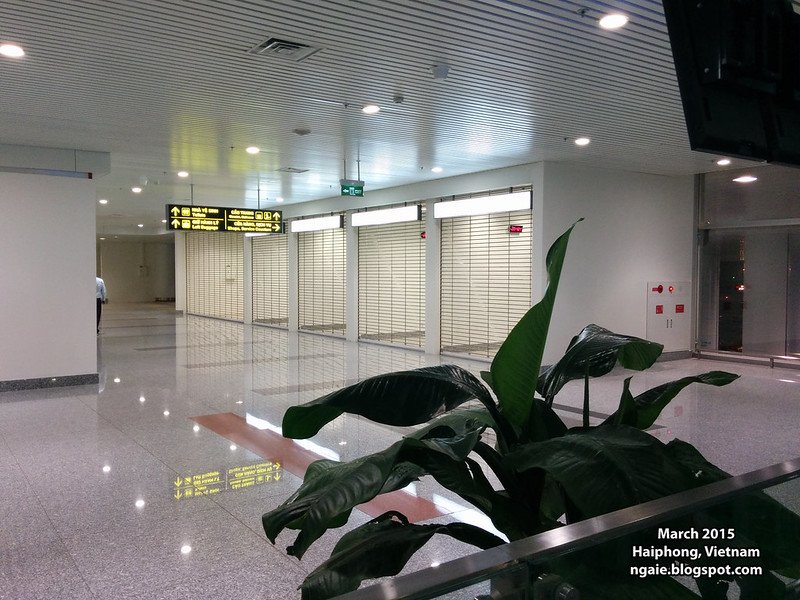
The arrival floor.
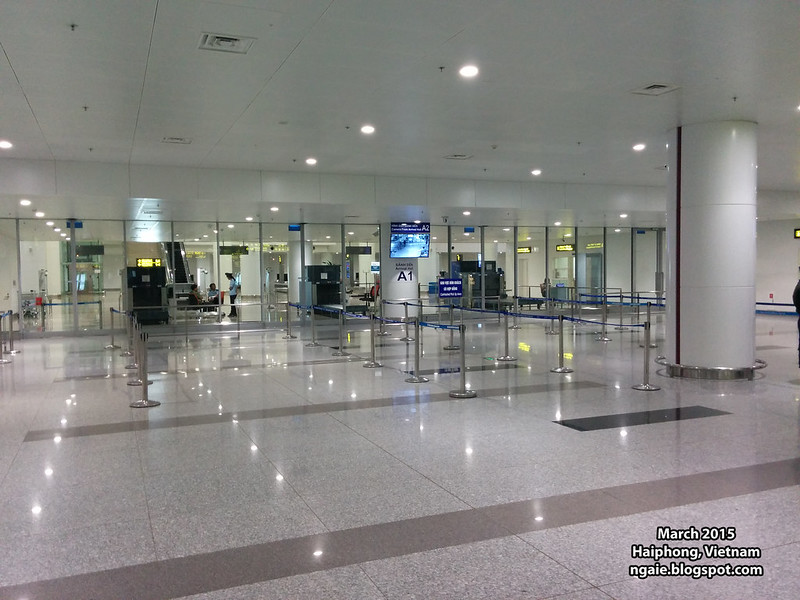
Too bad I had already eaten, I really wanted to get some Popeyes fried chicken.
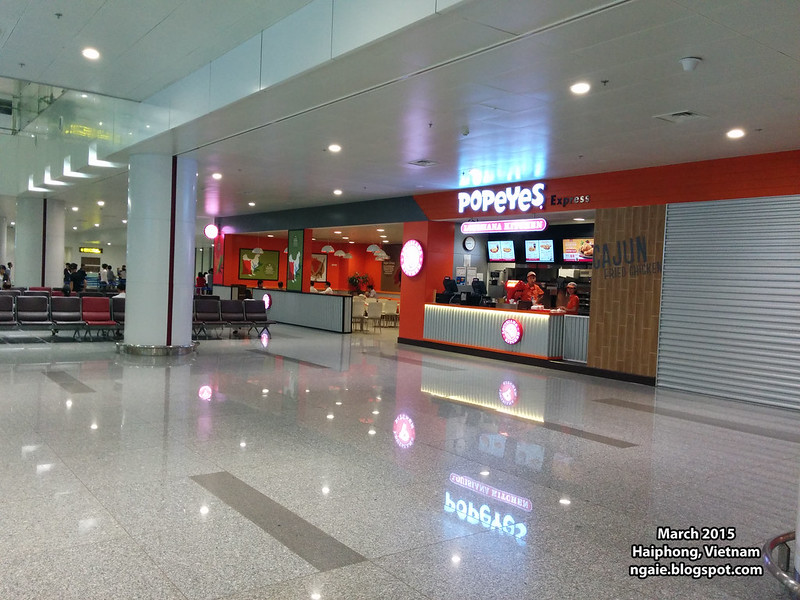
Localized fast food.
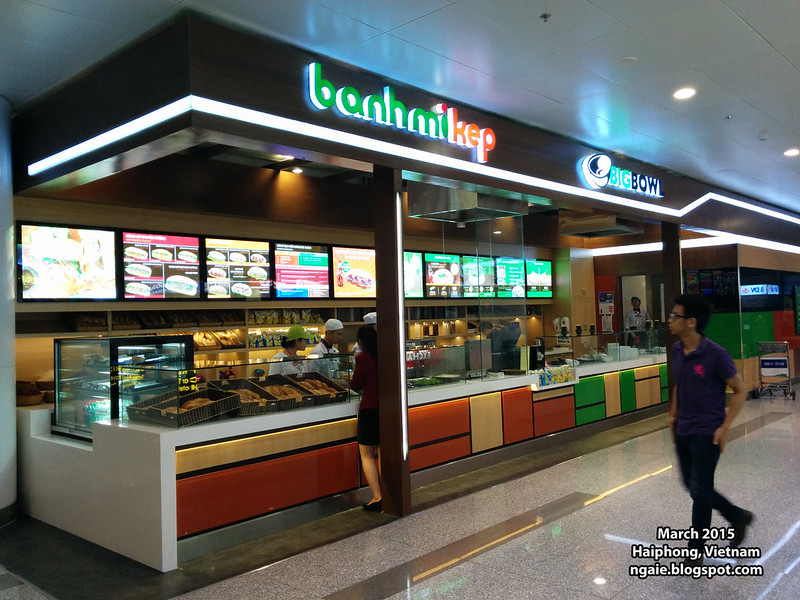
In the secure area.
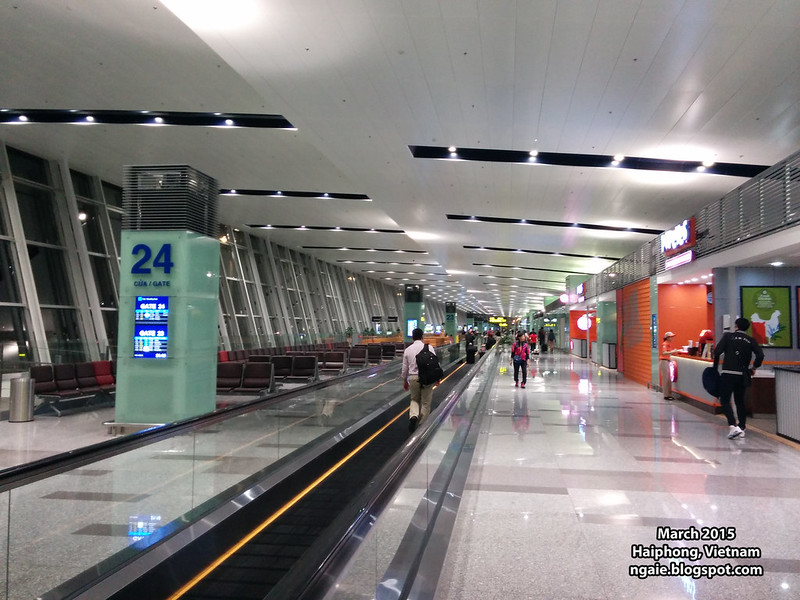
One of the odd things about Vietnam airports is that before security on the departure level, everything is priced in the local currency but once you pass security, everything is priced in US dollars. Here at the duty free shop, they were selling giant boxes of Tic Tacs for US$45.00 at the duty free shop!
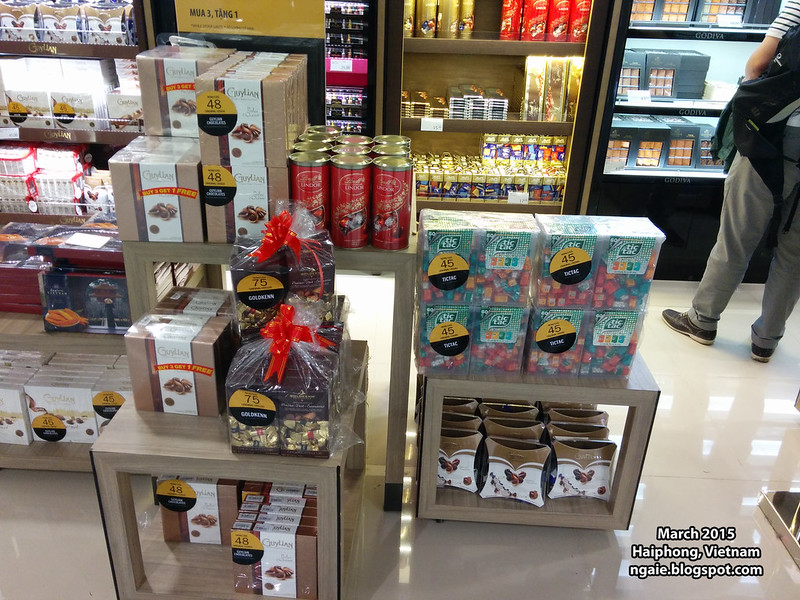

0 comments:
Post a Comment